Dear visitor,
The Armenian Genocide Museum-Institute will be closed from December 31 till January 2, 2023.
Sincerely,
The Armenian Genocide Museum-Institute Foundation
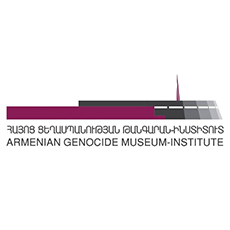
Statement of the “Armenian Genocide Museum-Institute” Foundation
27.12.2022
Since December 12, 2022, Azerbaijan has blocked the only road connecting the Republic of Artsakh to the world. Despite the various pretenses put forward by Azerbaijan, the strategic goal is to force the population of the Republic of Artsakh to leave its historical homeland. Here, Azerbaijan is guided by the same plan - that is to gradually turn Artsakh into Nakhichevan: there are no Armenians - there are no problems. At the same time, Azerbaijan will obviously not be satisfied with the depopulation of Artsakh. After the second Artsakh war in 2020, the public statements made by the military and political leadership of Azerbaijan clearly testify about its territorial ambitions towards the Republic of Armenia, including the capital Yerevan.
The military-political leadership of Azerbaijan is excited about the growing importance of Azerbaijan’s role due to the latest geopolitical developments, including the growing opportunities to export Turkmen gas to international markets through the territory of Azerbaijan.
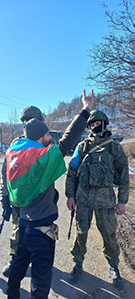
The blockade of Artsakh: Are we capable to prevent the genocide?
16.12.2022
While in many corners of the world, people are preparing to celebrate Christmas and the New Year, December of 2022 became yet another disastrous month for 120k Artsakh Armenians (of which 30K kids). It is the second time this month that the regime of Baku has blocked the Lachin Corridor, the only road connecting the Artsakh Armenians to the world. The Lachin Corridor is a road connecting Artsakh to Armenia. The Russian peacekeeping force is responsible for it in accordance with the 2020 Nagorno-Karabakh agreement signed on November 9 by the President of Azerbaijan, Ilham Aliyev, the Prime Minister of Armenia, Nikol Pashinyan and the President of Russia, Vladimir Putin.
The second blockade of the Corridor began on December 12 when so-called Azerbaijani "environmentalists" started their protests, closing the road near the city of Shushi (a part of Nagorno-Karabakh that is now under Azerbaijani control). The reality is, however, that covered by the "environmentalist" rhetoric, the Azerbaijani government cut the road creating a high risk of ethnic cleansing and yet another humanitarian crisis. In reality, the so-called "eco-activists" are soldiers of the Azerbaijani army or members of organizations financed by the Aliyev regime.
In this challenging situation, many started talking about the possible genocide or ethnic cleansing of Artsakh Armenians by the government of Azerbaijan. Among them was the Prime Minister of Armenia, Nikol Pashinyan, who, in his opening remarks at the 4th Global Forum Against the Crime of Genocide, mentioned three possible scenarios that Azerbaijan can use for its genocidal intentions. "The Lachin Corridor is a genocide prevention corridor. To close that Corridor, to stop the activity of that Corridor, means to condemn the Armenians of Nagorno-Karabakh [(Artsakh)] to genocide [by Azerbaijan] in three different scenarios," said Pashinyan.
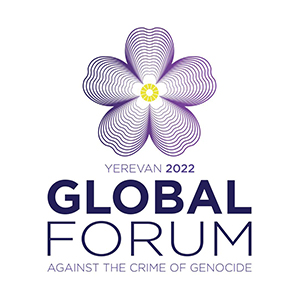
Statement on the Goris-Stepanakert Corridor Closure
15.12.2022
A group of international genocide scholars and educators, who attended the International Global Forum against the Crime of Genocide in Yerevan on December 12-13, released a joint statement condemning the ongoing Azerbaijani blockade of the sole road connecting Artsakh (Nagorno-Karabakh) to Armenia, known as the Lachin Corridor.
"We, the undersigned international genocide studies scholars and educators, condemn the actions of the Azerbaijani government in creating a humanitarian crisis for Nagorno-Karabakh by closing of the Goris-Stepanakert corridor on Dec. 12, 2022 and cutting gas supplies to the Armenian population. As scholars who study the process of genocide, we believe that the actions of the Azerbaijani government constitute a risk of genocide for the Armenians of the region. We urge international agencies and governments to ensure the free access of people and goods to Nagorno-Karabakh.
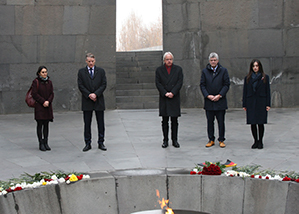
The delegation headed by the German Bundestag deputy Christian Haase visited the Armenian Genocide Memorial
08.12.2022
The delegation headed by Christian Haase, Member of the Bundestag of the Federal Republic of Germany, which included Dr. Herbert Grieshop, Head of the External Relations Department of the Free University of Berlin, and Dr. Andreas Trump, Head of the Hotline Research Service, visited the Armenian Genocide Memorial on December 8.
The guests were welcomed by Lusine Abrahamyan, the AGMI Deputy Director for Museum Affairs, who presented the history of the creation of the Memorial. She also presented the history of the three khachkars placed in the Tsitsernakaberd area in memory of the Armenians who died in the massacres organised by the Azerbaijani government in the cities of Sumgait, Kirovabad (Gandzak), and Baku in the last century, emphasizing the connection between what happened and the Armenian Genocide.
Dear visitor,
From December 1, 2022 to February 28, 2023, the working hours of the Armenian Genocide Museum are from 11:00 to 16:30, the last entry for the visitors is at 16:00.
Sincerely,
The Armenian Genocide Museum-Institute Foundation
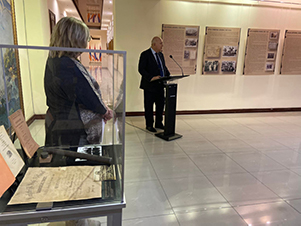
The opening of the travelling exhibition titled “Tracing Armenian Schools in the Ottoman Empire: An Enlighted Nation’s Certificates” at the Armenian State Pedagogical University (ASPU)
18.11.2022
As part of the events dedicated to the 100th anniversary of the foundation of the Khachatur Abovyan Armenian State Pedagogical University (ASPU), the ceremonial opening of the travelling temporary exhibition titled “Tracing the Armenian Schools in the Ottoman Empire: An Enlighted Nation’s Certificates” took place in university’s history museum hall on November 15.
The event was also attended by AGMI Director Harutyun Marutyan as well as Seda Parsamyan, the creator of this exhibition and who is generally responsible for organising AGMI exhibitions. Srbuhi Gevorgyan, the rector of the ASPU, members of the university teaching staff, students and employees of AGMI were also present.
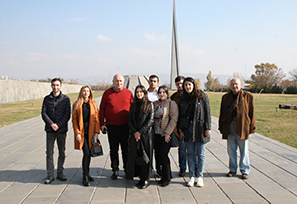
A group of master’s degree students from the Yerevan State University’s Faculty of International Relations visited the AGMI
17.11.2022
A group of master’s degree students from the YSU Faculty of International Relations, with their lecturer Gurgen Hovhannisyan, were received today at the AGMI on the occasion of the International Students’ Day where they had a meeting-discussion with Harutyun Marutyan, AGMI Director.
First AGMI Director Harutyun Marutyan accompanied the students to the Genocide monument complex and gave them the history of complex’s creation. He also described the history of the three khachkars placed in the Tsitsernakaberd area in memory of the Armenians who died in the massacres in the cities of Sumgait, Kirovabad (Gandzak), and Baku in the last century, organised by the Azerbaijani government. He also told the stories of the five freedom fighters who died during the Artsakh war who are buried in front of Memory Wall (Hushapat) emphasising the connection between what happened and the Armenian Genocide. Mr. Marutyan also told them the history of the Memory Wall, the reverse of which holds relics of foreign public figures, politicians, and missionaries who raised their voices in protest against the Armenian Genocide carried out by the Turkish government.
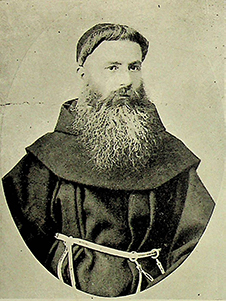
ARCHIVAL DOCUMENTS RECENTLY RECEIVED BY THE AGMI:
TRACING THE BEATIFICATION PROCESS OF THE ITALIAN MONK SALVATORE LILLI
15.11.2022
The Armenian Genocide Museum-Institute (AGMI) received a package of materials for archival preservation from the Ministry of Foreign Affairs of the Republic of Armenia in June this year. It mainly consisted of documents in Italian. As reported in the letter attached, sent by the Ministry of Foreign Affairs of the Republic of Armenia, a gentleman named Mr. Talal Khrais, the founder of the Italo-Arab “Assadakah” association, handed these archival materials to Mrs. Tsovinar Hambardzumyan, Ambassador Extraordinary and Plenipotentiary of the Republic of Armenia in the Italian Republic. According to Mr. Khrais, a brick maker named Salvatore Gargano discovered the said archival materials during renovation works carried out on the monastery of Oriolo Romano (a commune in Viterbo, Lazio). These archival materials are a collection of historical documents amassed to examine the circumstances of Italian-born Franciscan friar Salvatore Lilli’s martyrdom and his subsequent beatification by the Catholic Church.
The materials consist of historical records, one letter from Father Salvatore addressed to the then Pope Pius IX (1846-1878), various ecclesiastical and secular officials, recorded testimonies collected during the investigation of the circumstances of Salvatore Lilli's martyrdom and photographs of witnesses. In those records, Salvatore Lilli, as an eyewitness, also described the repressions carried out by the Ottoman Empire against the Armenian population.
Salvatore Lilli, the son of Vincenzo and Annunziata Lilli, was born in Comune di Cappadocia in the L'Aquila province of the Abruzzo region of Central Italy on June 19, 1853.
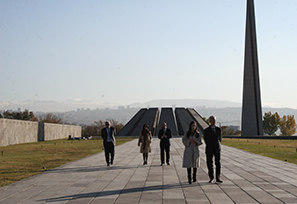
Kypros Giorgallis, Ambassador of the Republic of Cyprus to Armenia, visited the Armenian Genocide Memorial
15.11.2022
A delegation led by Kypros Giorgallis, the newly appointed ambassador of the Republic of Cyprus to Armenia (residence in Moscow), visited the Armenian Genocide Memorial on November 15.
The guests were welcomed by Harutyun Marutyan, AGMI Director who narrated the history of the creation of the memorial. He also told the history of the three khachkars placed in the Tsitsernakaberd area in memory of the Armenians who died in the massacres in the cities of Sumgait, Kirovabad (Gandzak) and Baku in the last century, organised by the Azerbaijani government. He also related the stories of the five freedom fighters killed during the Artsakh buried and buried in front of the Memory Wall (Hushapat) war, emphasizing the connection between what happened then and the Armenian Genocide.
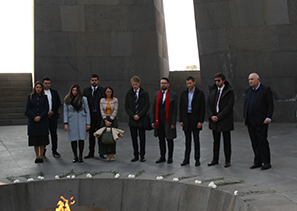
OSCE Parliament Assembly Deputies visited the Armenian Genocide Memorial
12.11.2022
OSCE Parliament Assembly deputies visited the Armenian Genocide Memorial, accompanied by a group of Republic of Armenia National Assembly deputies on November 12.
The guests were welcomed by Harutyun Marutyan, AGMI Director who narrated the history of the creation of the Memorial. He also presented them with the history of the three khachkars placed in the Tsitsernakaberd area in memory of the Armenians who died in the massacres in the cities of Sumgait, Kirovabad (Gandzak) and Baku in the last century organised by the Azerbaijani government. He also related the stories of the five freedom fighters buried in front of the Memory Wall (Hushapat) who were killed during the Artsakh war, emphasizing the connection between what happened and the Armenian Genocide.
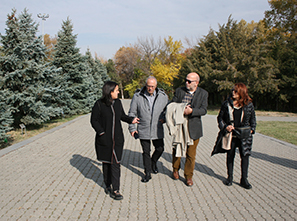
Greek MPs visit the Armenian Genocide Memorial
09.11.2022
Members of the Greek parliament visited the Armenian Genocide Memorial on November 9.
Edita Gzoyan, Deputy Scientific Director of the Armenian Genocide Museum-Institute, welcomed the guests. She provided the delegation with the history of the three khachkars placed in the Tsitsernakaberd area in memory of the Armenians who died in the massacres in the cities of Sumgait, Kirovabad (Gandzak) and Baku in the last century that were organised by the Azerbaijani government. She also told the stories of the five freedom fighters buried in front of the Memorial Wall (Hushapat) who were killed during the Artsakh war, stressing the link with the Armenian Genocide.
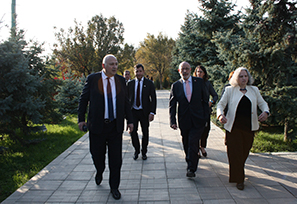
High-ranking officials of Israel’s Ministry of Foreign Affairs visited the Armenian Genocide Museum
08.11.2022
Simona Halperin, Deputy Director General of Israel’s Ministry of Foreign Affairs, Head of the Eurasia and Western Balkans Department and Michal Hershkovitz, Director of the Central Asia and Caucasus Department, visited the Armenian Genocide Museum on November 8, accompanied by Israel’s Ambassador to Armenia Joel Lioni and Israel’s Honorary Consul to Armenia, Ashot Shakhmuradyan.
The guests were welcomed by Harutyun Marutyan, AGMI Director, who presented the history of the creation of the memorial.
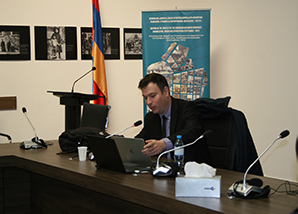
The Armenian Genocide at the European Court of Human Rights
Prof. Thomas Hochmann’s second lecture
03.11.2022
Professor Thomas Hochmann of the University of Nanterre, Paris, delivered his second lecture titled “The Armenian Genocide before the European Court of Human Rights” in the AGMI conference hall yesterday. It was dedicated to the “Perinchek v. Switzerland” case that has been under way in the ECHR for almost two-years.
Professor Hochmann presented the process of the case in detail and referred to the decisions made by the Chamber and the Grand Chamber, showing their flawed aspects.
Unlike the Chamber of the ECHR, it was stated, in the judgment adopted by the Grand Chamber in October 2015, that the court was not obliged to determine whether the massacres and mass deportations of the Armenian people by the Ottoman Empire may be described as genocide and that the court did not have the authority to issue legally binding statements. Seven of the 17 judges of the Grand Chamber, including the President of the ECHR, stated in their special opinion that the massacres and deportations suffered by the Armenian people were genocide and that the Armenian Genocide is a clearly established historical fact.
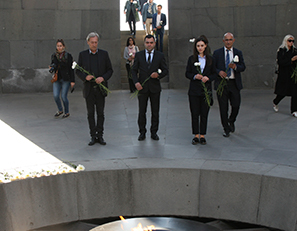
The President of the French Department of Hauts-de-Seine, George Siffredi, visited the Armenian Genocide Memorial
02.11.2022
On November 2, the delegation led by the President of the French Haut-de-Seine Department, Georges Siffredi, visited the Armenian Genocide Memorial, accompanied by the Deputy Governor of Tavush, Narek Ghushchyan.
The guests were welcomed by Lusine Abrahamyan, the AGMI Deputy Director for Museum Affairs, who presented the history of the creation of the Memorial. She also presented the history of the three khachkars placed in the Tsitsernakaberd area in memory of the Armenians who died in the massacres organised by the Azerbaijani government in the cities of Sumgait, Kirovabad (Gandzak), and Baku in the last century, stressing that what happened was a continuation of the Armenian Genocide.
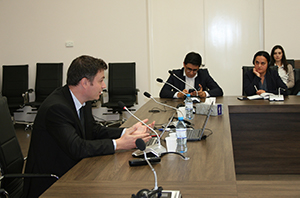
Professor Thomas Hochmann’s AGMI lecture
01.11.2022
Professor Thomas Hochmann of the University of Nanterre, Paris, delivered a lecture titled “Genocide denial in French law” in the AGMI conference hall on November 1st.
Edita Gzoyan, AGMI Deputy Director for Scientific Works, presented Prof. Thomas Hochmann’s activities to the attendees.
During his lecture, Professor Hochmann referred to the adoption of laws by the French National Assembly on the criminalisation of the denial of the Armenian Genocide enacted in various years. According to him, one group of specialists believes that the denial of genocides contradicts the right to freedom of speech, while the other believes that, in this case, restricting freedom of speech prevents the rooting-out of racist sentiments and hate speech.
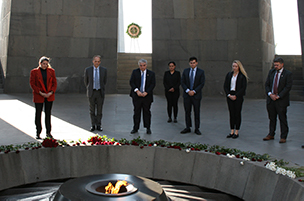
The USAID delegation visited the Armenian Genocide Memorial
31.10.2022
The delegation, led by Mrs. Erin Mckee, the head of the Europe and Eurasia Bureau of USAID, visited the Armenian Genocide Memorial on October 31.
Edita Gzoyan, Deputy Scientific Director of the Armenian Genocide Museum-Institute, welcomed the guests. She gave the delegation the history of the three khachkars placed in the Tsitsernakaberd area in memory of the Armenians who died in the massacres in the cities of Sumgait, Kirovabad (Gandzak) and Baku in the last century that were organised by the Azerbaijani government. She also told the stories of the five freedom fighters buried in front of the Wall of Remembrance (Hushapat) who were killed during the Artsakh war, stressing the link of these to the Armenian Genocide.
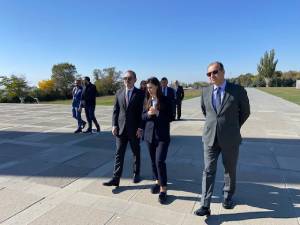
Andreas Katsaniotis, Greek Deputy Foreign Minister, visited the Armenian Genocide Memorial
30.10.2022
The Greek delegation, headed by Andreas Katsaniotis, Deputy Foreign Minister, visited the Armenian Genocide Memorial on October 30.
The guests were welcomed by Lusine Abrahamyan, AGMI Deputy Director for Museum Affairs, who presented the history of the creation of the Memorial. She also presented them with the history of the three khachkars placed in the Tsitsernakaberd area in memory of the Armenians who died in the massacres in the cities of Sumgait, Kirovabad (Gandzak), and Baku in the last century organised by the Azerbaijani government, stressing that what happened was a continuation of the Armenian Genocide.
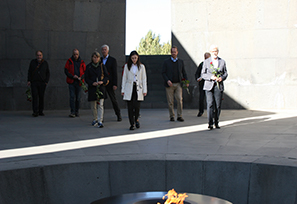
Klaus Pavel, head of Germany’s “Charity Kitchen” management committee, visited the Armenian Genocide Memorial
29.10.2022
A delegation, led by Klaus Pavel, the former governor of the Ostalbi district and head of Germany’s “Charity Kitchen” management committee, visited the Armenian Genocide memorial complex on October 29.
The guests were welcomed by Lusine Abrahamyan, AGMI Deputy Director for Museum Affairs, who described the history of the creation of the memorial. She also presented the history of the three khachkars placed in the Tsitsernakaberd area in memory of the Armenians who died in the massacres organised by the Azerbaijani government in the cities of Sumgait, Kirovabad (Gandzak), and Baku in the last century, stressing that those events were a continuation of the Armenian Genocide itself.
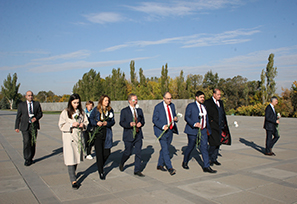
French deputies visited the Armenian Genocide Memorial
28.10.2022
Deputies of the French National Assembly, accompanied by the head of the Armenia-France friendship group of the Republic of Armenia’s National Assembly, Vladimir Vardanyan, visited the Armenian Genocide Memorial on October 28.
The guests were welcomed by Lusine Abrahamyan, AGMI Deputy Director for Museum Affairs, who described the history of the creation of the memorial. She also presented the history of the three khachkars placed in the Tsitsernakaberd area in memory of the Armenians who died in the massacres organised by the Azerbaijani government in the cities of Sumgait, Kirovabad (Gandzak), and Baku in the last century.
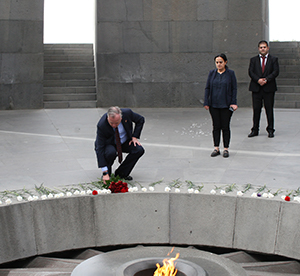
Mark Cameron, Director of the Office of the Caucasus and Regional Conflicts of the US Department of State, visited the Armenian Genocide Memorial
27.10.2022
Mark Cameron, director of the Office of the Caucasus and Regional Conflicts of the US Department of State, visited the Armenian Genocide Memorial on October 27.
Edita Gzoyan, AGMI Deputy Scientific Director, welcomed the guests. She told the delegation the history of the three khachkars placed in the Tsitsernakaberd area in memory of the Armenians who died in the massacres organised by the Azerbaijani government in the cities of Sumgait, Kirovabad (Gandzak) and Baku in the last century, as well as the stories of the five freedom fighters who are buried in front of the Memorial Wall, stressing that the events were a continuation of the Armenian Genocide. She also referred to the historical and legal aspects of the Artsakh issue, presenting Azerbaijan's anti-Armenian actions and propaganda.
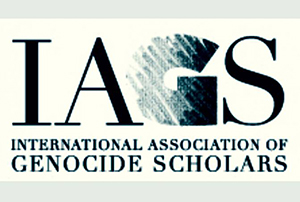
Statement on Azerbaijani Aggression Against the Republic of Armenia and the Indigenous Armenians of the South Caucasus
25.10.2022
The International Association of Genocide Scholars Executive Board strongly condemns Azerbaijan’s invasion of the Republic of Armenia and the ongoing aggression against the Armenian people in the Republic and in Artsakh (Nagorno Karabakh) and expresses concern about the risk of genocide against the Armenian population of that entity.
On 13 September 2022, Azerbaijan launched an attack on the sovereign territory of the Republic of Armenia. Using heavy artillery as well as multiple rocket launchers and attack drones, the Azerbaijani forces shelled the cities and towns of Vardenis, Goris, Ishkanasar, Kapan, Sotk, Artanish, and Jermuk and the surrounding villages in the Republic of Armenia. This attack resulted in over 210 confirmed deaths of Armenian soldiers and numerous civilian deaths and injuries. While a tenuous ceasefire still holds, Azerbaijan’s violence continues, including allegations of executions of Armenian prisoners of war. Over 7,000 civilians have been displaced, and civilian
homes and local infrastructure destroyed in an attempt to ethnically cleanse Armenians from a large portion of the Republic of Armenia.
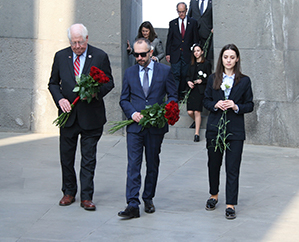
U.S. Congressional Delegation visited the Armenian Genocide Memorial
18.10.2022
On October 18, the U.S. Congressional Delegation led by by House Democracy Partnership Commission Chairman David Price visited the Armenian Genocide Memorial, accompanied by Eduard Aghajanyan, Chairman of the National Assembly’s Standing Committee on Foreign Relations.
The guests were welcomed by Lusine Abrahamyan, the AGMI Deputy Director for Museum Affairs, who presented the history of the creation of the Memorial. She also presented the history of the three khachkars placed in the Tsitsernakaberd area in memory of the Armenians who died in the massacres organised by the Azerbaijani government in the cities of Sumgait, Kirovabad (Gandzak), and Baku in the last century.
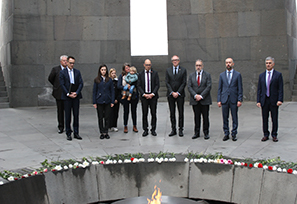
Swiss parliamentary delegation visited the Armenian Genocide Memorial
15.10.2022
Stefan Müller-Altermatt and Michel Mater, members of the National Council of the Swiss Confederation, visited the Armenian Genocide Memorial on October 15, accompanied by Eduard Aghajanyan, Chairman of the National Assembly’s Standing Committee on Foreign Relations, Stefano Lazzarotto, Ambassador Extraordinary and Plenipotentiary of Switzerland to Armenia, and Sargis Shahinyan, Secretary General of the Switzerland-Armenia Parliamentary Friendship Group.
The guests were welcomed by Lusine Abrahamyan, the AGMI Deputy Director for Museum Affairs, who presented the history of the creation of the Memorial. She also presented the history of the three khachkars placed in the Tsitsernakaberd area in memory of the Armenians who died in the massacres organised by the Azerbaijani government in the cities of Sumgait, Kirovabad (Gandzak), and Baku in the last century.
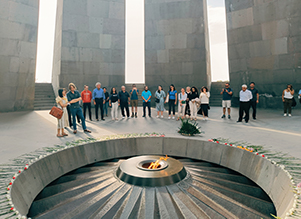
Members of the Young Men’s Christian Association (YMCA) visited the Armenian Genocide Memorial
07.10.2022
Members of the Young Men’s Christian Association (YMCA) visited the Armenian Genocide Memorial on October 5.
The guests were welcomed by the Deputy Scientific Director of the Armenian Genocide Museum-Institute Edita Gzoyan, who presented the history of the creation of the Memorial. She gave the delegation the history of the three khachkars placed in the Tsitsernakaberd area in memory of the Armenians who died in the massacres organised by the Azerbaijani government in the cities of Sumgait, Kirovabad (Gandzak), and Baku in the last century, and the stories of the five freedom fighters buried in front of Hushapat (Memory Wall) during the Artsakh war, stressing that what happened was a continuation of the Armenian Genocide.
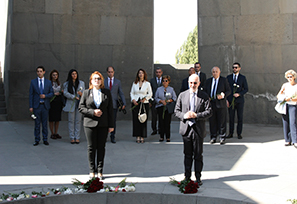
The visit of Pietro Curzio, President of the Italian Court of Cassation, to the Armenian Genocide Memorial
01.10.2022
On October 1, the delegation led by the President of the Italian Court of Cassation, Pietro Curzio, who arrived in Armenia on a working visit, visited the Armenian Genocide Memorial, accompanied by the President of the RA Court of Cassation, Lilit Tadevosyan, Italian Ambassador Extraordinary and Plenipotentiary to Armenia, Alfonso Di Rizzo, and RA Ambassador Extraordinary and Plenipotentiary to Italy, Tsovinar Hambardzumyan.
The guests were welcomed by the Director of the Armenian Genocide Museum-Institute Harutyun Marutyan, who presented the history of the creation of the Memorial. She gave the delegation the history of the three khachkars placed in the Tsitsernakaberd area in memory of the Armenians who died in the massacres organised by the Azerbaijani government in the cities of Sumgait, Kirovabad (Gandzak), and Baku in the last century.
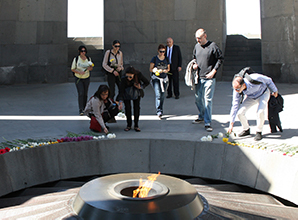
The visit of the Greek parliamentary delegation to the Armenian Genocide Memorial
27.09.2022
The Greek parliamentary delegation, which arrived in Armenia on a working visit, visited the Armenian Genocide Memorial on September 27.
The guests were welcomed by the AGMI Director Harutyun Marutyan, who presented the history of the creation of the Memorial. She gave the delegation the history of the three khachkars placed in the Tsitsernakaberd area in memory of the Armenians who died in the massacres organized by the Azerbaijani government in the cities of Sumgait, Kirovabad (Gandzak), and Baku in the last century.
The Greek guests laid flowers at the Eternal Fire and observed a minute of silence in memory of the innocent martyrs of the Armenian Genocide.
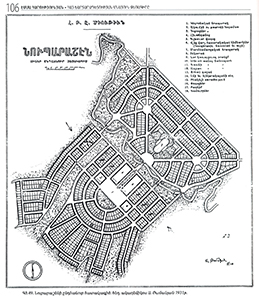
THE 13TH STREET OF NUBARASHEN HAS BEEN NAMED “NEW SMYRNA”
The history of the foundation of the small town of Nubarashen
23.09.2022
On April 19, 2022, the Yerevan Council of Elders adopted a decision to name the 13th street of Nubarashen “New Smyrna”. Within the framework of the three-day international conference titled “Smyrna in the context of the Armenian and Greek genocides: annihilation, arson and deportation (September 1922),” the participants visited Nubarashen to attend the naming ceremony of New Smyrna street.
The construction of Nubarashen is connected with the name and activities of the Armenian national philanthropist Boghos Nubar Pasha. His father, Nubar Pasha (1825-1899), the first prime minister of Egypt, was born and educated in Smyrna, later moving to Egypt. The Nubarians are descended from the branch of Mkrtich Nubar’s family. He was a merchant who migrated from Artsakh to Smyrna at the end of the 18th century and was well known in Smyrna. Boghos Nubar (1851-1930), a prominent Armenian political figure, founder and first president of the Armenian General Benevolent Union (AGBU), was born in Constantinople, receiving his agricultural education first in France and then in Switzerland. Boghos Nubar was appointed the leader and authorised representative of the Armenian national delegation, with a mandate to protect the cause and rights of the Armenian people at conferences to be convened in European countries, under the terms of the pastoral letter granted to him by the Catholicos of All Armenians, Gevorg V Sureniants, in 1912.
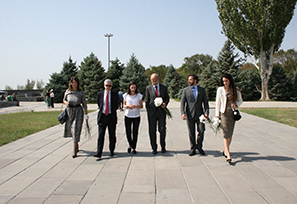
The newly appointed Ambassador of the Kingdom of Spain to Armenia (residence: Moscow) Marcos Gomez Martinez visited the Armenian Genocide Memorial
23.09.2022
The newly appointed ambassador of the Kingdom of Spain to Armenia (residence: Moscow), Mr. Marcos Gomez Martinez, who arrived in Armenia on an official visit, visited the Armenian Genocide Memorial on September 23, accompanied by Honorary Consul of the Kingdom of Spain in Armenia Armine Adamyan.
The guests were welcomed by the AGMI Deputy Director for Museum Affairs Lusine Abrahamyan, who presented the history of the creation of the Memorial. She gave the delegation the history of the three khachkars placed in the Tsitsernakaberd area in memory of the Armenians who died in the massacres organised by the Azerbaijani government in the cities of Sumgait, Kirovabad (Gandzak), and Baku in the last century.
Dear visitor,
The museum will be closed on September 21.
Sincerely,
The Armenian Genocide Museum-Institute Foundation
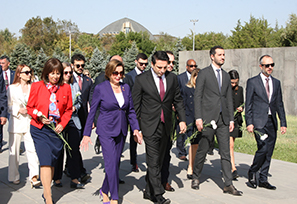
The visit made by Nancy Pelosi, Speaker of the House of Representatives of the US Congress, to the Armenian Genocide Memorial
18.09.2022
The delegation, led by Nancy Pelosi, Speaker of the House of Representatives of the US Congress, accompanied by RA NA Speaker Allen Simonyan, RA Ambassador to USA Lilit Makunts and U S Ambassador to Armenia Lynn Tracy visited the Armenian Genocide Memorial on September 18.
Edita Gzoyan, Deputy Scientific Director of the Armenian Genocide Museum-Institute, welcomed the guests. She gave the delegation the history of the three khachkars placed in the Tsitsernakaberd area in memory of the Armenians who died in the massacres organised by the Azerbaijani government in the cities of Sumgait, Kirovabad (Gandzak), and Baku in the last century. She also told the stories of the five freedom fighters buried in front of the Wall of Remembrance (Hushapat) who were killed during the Artsakh war, stressing that what happened was a continuation of the Armenian Genocide. She also referred to the historical and legal aspects of the Artsakh issue, presenting Azerbaijan's anti-Armenian actions and propaganda.
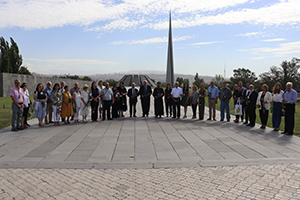
SUMMARY OF THE WORK OF THE THREE-DAY INTERNATIONAL CONFERENCE TITLED “SMYRNA IN THE CONTEXT OF THE ARMENIAN AND GREEK GENOCIDES; ANNIHILATION: ARSON AND DEPORTATION (SEPTEMBER 1922)”
17.09.2022
The three-day international conference “Smyrna in the context of the Armenian and Greek genocides: annihilation, arson and deportation (September 1922),” organised by the “Armenian Genocide Museum-Institute” took place from September 14 to 16, 2022, (the co-organisers were: YSU Institute of Armenian Studies, RA NAS Institute of History, K. Abovyan Armenian State Pedagogical University, Haykazian University of Beirut and the Aristotle University of Thessaloniki Pontic Studies Department).
The conference was launched by an opening speech made by AGMI Director Harutyun Marutyan. He said: “Today, in the days of undisguised Azerbaijani aggression, we have convened a conference dedicated to the consequences of another - similar - act that took place a century ago. 100 years ago, thousands of innocent citizens were being killed while today, Armenian soldiers are the victims, defending the borders of the Republic of Armenia from their combat positions. Our so-called neighbour’s aggressive behaviour has not changed; they still profess the same “values” as they did 100 years ago. We must clearly realise this while building relationships.” The attendees observed a minute’s silence, at Harutyun Marutyun’s suggestion, in memory of those who died because of the aggression unleashed by Azerbaijan on September 13.
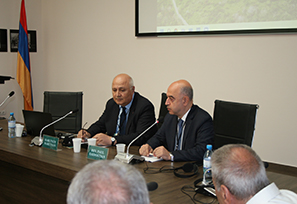
THE OPENING OF THE INTERNATIONAL CONFERENCE AND TEMPORARY EXHIBITION AT THE ARMENIAN GENOCIDE MUSEUM-INSTITUTE
14.09.2022
The three-day international conference titled “Smyrna in the context of the Armenian and Greek genocides: annihilation, arson and deportation (September 1922)” was launched today in the Armenian Genocide Museum-Institute conference hall (co-organisers: YSU Institute of Armenian Studies, RA NAS Institute of History, Kh. Abovyan Armenian State Pedagogical University, Haykazian University of Beirut and the Aristotle University of Thessaloniki Pontic Studies Department).
The conference was launched by AGMI Director Harutyun Marutyan’s opening speech. He said: “Today, in the days of undisguised Azerbaijani aggression, we are convening a conference dedicated to the consequences of another act of Turkish aggression that took place a century ago. 100 years ago, thousands of innocent citizens were being killed and today, the victims are the Armenian soldiers defending the borders of the Republic of Armenia in their combat positions. The aggressive behavior of our so-called neighbours has not changed; they still profess the same "values" as they did 100 years ago. We should clearly realise this while building relationships.” The attendees observed, at Harutyun Marutyun’s suggestion, a minute’s silence in memory of those who died because of the aggression unleashed by Azerbaijan on September 13.
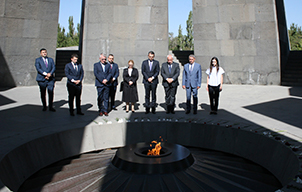
Romanian Deputy Foreign Minister Iulian Fota visited the Armenian Genocide Memorial
13.09.2022
On September 13, the delegation headed by Deputy Foreign Minister of Romania Iulian Fota visited the Armenian Genocide Memorial, accompanied by RA Ambassador to Romania Sergey Minasyan and representative of the European Department of RA MFA Hayk Khemchyan.
The guests were welcomed by the AGMI Deputy Director for Museum Affairs Lusine Abrahamyan, who presented the history of the creation of the Memorial. She also related the story of the 3 khachkars placed in Tsitsernakaberd Park and dedicated to the memory of the Armenians who perished during the ethnic cleansing of the Armenian population within Azerbaijan at the end of the last century.
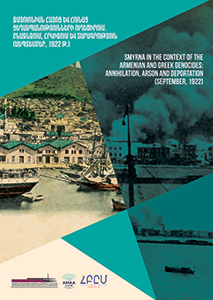
PRESS RELEASE
10.09.2022
The “Armenian Genocide Museum-Institute” foundation will be holding a three-day international conference in its conference hall titled “Smyrna in the context of the Armenian and Greek
genocides: annihilation, arson and deportation (September 1922)” which will open at 9:00am on September 14th, 2022 (the co-organisers are Yerevan State University’s Armenology Research
Institute, K. Apovyan Armenian State Pedagogical University, Haigazian University of Beirut and Aristotle University of Thessaloniki’s Pontic Studies Department).
Experts on genocide, as well as historians, ethnographers, technologists, psychologists and specialists in law from Armenia, Greece, Lebanon, USA, Canada, the Netherlands,
Italy and the Czech Republic will be participating.
The official opening of the temporary exhibition of the same title will be taking place at 10:40am. The bilingual display (in Armenian and English), made up of thirteen panels,
has been created from the Armenian Genocide-Museum’s collections, survivors heirs’ archives as well as from various items from other collections.
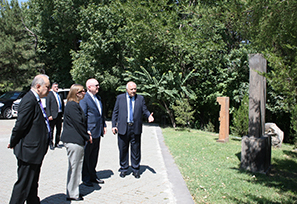
The visit of OSCE Minsk Group Co-Chair of US Philip Reeker to the Armenian Genocide Memorial
08.09.2022
On September 8, the delegation led by the OSCE Minsk Group Co-Chair of US, Senior Advisor for Caucasus Negotiations Philip Reeker visited the Armenian Genocide Memorial, accompanied by Armen Yeganyan, Head of the Department of American Countries of the RA Foreign Ministry, and US Ambassador to Armenia Lynn Tracy.
The guests were welcomed by the AGMI Director Harutyun Marutyan, who presented the story of the 3 khachkars placed in Tsitsernakaberd Park and dedicated to the memory of the Armenians who perished during the ethnic cleansing of the Armenian population within Azerbaijan at the end of the last century.
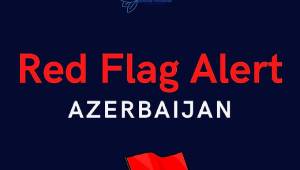
Red Flag Alert - Azerbaijan Update
20.08.2022
The Lemkin Institute calls on all international and state bodies to monitor Turkey and Azerbaijan for genocidal ideology and practices, to place pressure on Turkey and Azerbaijan to cease their genocidal threats against the Armenian people, and to reinforce the security of Armenians and the Armenian identity in the Republic of Armenia, the Republic of Artsakh, and in Diaspora communities worldwide.
A recent Telegram video making its way through Azerbaijani social media shows an Azerbaijani soldier tying what is allegedly an Armenian skull dug up from a nearby Armenian cemetery to the back of a military truck while fellow soldiers cheer.
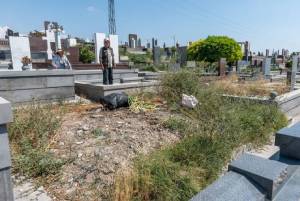
Zoryan Institute of Armenia responds to criticism on condition of Professor Dadrian’s grave
17.08.2022
The Zoryan Institute of Armenia responded to criticism on the condition of the grave of Professor Vahakn Dadrian in the Yerevan Municipal Pantheon.
“Professor Vahakn Dadrian was interred in Armenia in August of 2019, according to his will and upon the consent of his family. The Government of Armenia, through its Embassy in Washington, D.C., and with the support of the Zoryan Institute of Armenia, made all necessary arrangements, including financial, and organized transportation of the late professor’s ashes to Yerevan, Armenia.
A special governmental funeral commission was formed, which oversaw plot allocation at the Yerevan Municipal Pantheon, which serves to properly provide last shelter to national heroes, and other prominent sons and daughters of the Armenian Nation.
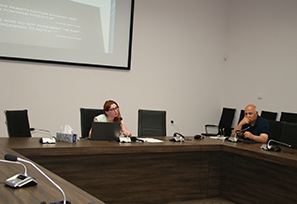
AGMI OPEN LECTURE
06.08.2022
Hasmik Martirosyan, senior guide and PhD student of the Armenian Genocide Museum-Institute, gave an open lecture titled “Presentation of the Holocaust theme through exhibitions and memorial sites of various museums” in the Armenian Genocide Museum-Institute’s conference hall on August 6.
She had, from June 24 to July 19 of this year, visited New York, then several cities in Poland within the framework of a programme organised by the Auschwitz Jewish Centre Foundation and the Holocaust Heritage Museum in New York. Her object was to study the presentation of the Holocaust theme in various museum exhibitions, through ghettos and concentration camps, monuments and other memorials. Ten graduate students and applicants participate in this programme each year. Hasmik Martirosyan was the first participant in the programme, that has been held for twenty years, from Armenia.
She presented, at the beginning of the lecture, some details of the programme itself, told of her experiences, meetings with witnesses and about the various lectures that were held during that month.
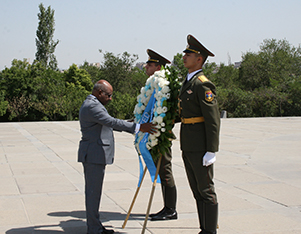
Visit of the President of the UN General Assembly to the Armenian Genocide Memorial
27.07.2022
On July 27, the delegation led by the President of the 76th Session of the UN General Assembly, Abdullah Shahid, visited the Armenian Genocide Memorial, accompanied by RA Deputy Foreign Minister Vahe Gevorgyan, RA Permanent Representative to the UN Mher Margaryan and UN Permanent Coordinator in Yerevan Lila Peters Yahia.
The guests were welcomed by the AGMI Director Harutyun Marutyan, who told them the history of the creation of the Memorial. He also presented to the guests the history of three khachkars (cross stones) installed in the territory of Tsitsernakaberd, which are dedicated to the memory of the Armenians who were perished during the ethnic cleansing of the Armenian population in the territory of Azerbaijan at the end of the last century.
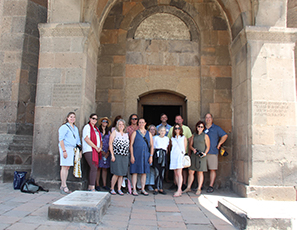
THE ARMENIAN GENOCIDE MUSEUM-INSTITUTE’S PROGRAMME OF TRAINING AMERICAN TEACHERS HAS BEEN COMPLETED
20.07.2022
The American "Genocide Education Project" organisation, in cooperation with the Armenian Genocide Museum-Institute, organised a training programme for American teachers from July 9 to 17, 2022. 15 teachers from the US states of Massachusetts, Indiana, Wisconsin, Tennessee, Missouri, Alaska, New Jersey, Pennsylvania, Connecticut, California, Oregon, Michigan, Virginia, and New York had been selected for it.
Not only was the teachers’ professional training impressive, but their work experience was too. Several of the participants had MA degrees in Holocaust and Genocide Studies, but three also had PhD history degrees. Two of the participants had also worked in genocide teaching training programmes in Cambodia and Rwanda. Five of the 15 participants created a subject concerning human rights and genocide studies, which they had imported to their educational institutions. Their teaching experience ranged from 20 to 24 years.
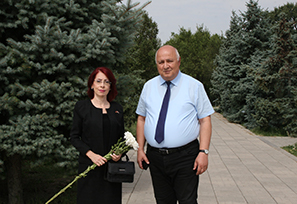
Nora Arissian, Syrian Ambassador to Armenia visited the Armenian Genocide Memorial
19.07.2022
Mrs. Nora Arissian, Ambassador Extraordinary and Plenipotentiary of the Syrian Arab Republic to Armenia and Consul Mr. Ahmad Hassan Alathba visited the Armenian Genocide Memorial on July 19.
The guests were welcomed by Harutyun Marutyan, AGMI Director, who told them the history of the creation of the Memorial.
They laid flowers at the Eternal Fire and honored the memory of the innocent martyrs with a minute’s silence. Harutyun Marutyan accompanied the guests to the Memory Wall, the reverse of which holds relics of foreign public figures, politicians, and missionaries who raised voices of protest against the Armenian Genocide carried out by the Ottoman government. The guests were introduced to the life and activities of Fayez al-Ghusein, an Arab jurist and witness of the Armenian massacres.
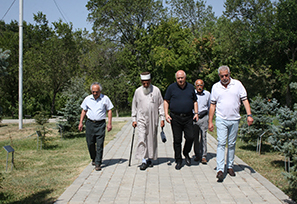
Sheikh Imran Hosein planted a fir tree in Memory Park in memory of the victims of the Armenian Genocide
16.07.2022
Sheikh Imran Hussain, a famous philosopher, preacher of Islam and universal values who lives in Belgium, recently visited the Armenian Genocide Museum and expressed his desire to plant a silver fir at Tsitsernakaberd ‘s summit.
Sheikh Imran Nazar Hosein is considered a unique commentator on the Quran who specialises in Islamic jurisprudence, world politics, economics, and contemporary socio-economic, political and international issues. He is the author of “Jerusalem in the Crimea” and other books.
He made a harsh speech during the 44-day war, condemning Azerbaijan and Turkey.
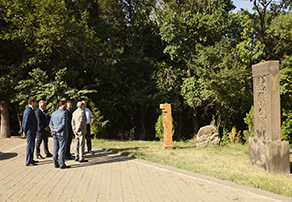
Vitaly Savelev, the Russian Federation’s Minister of Transport, visited the Armenian Genocide Memorial
16.07.2022
A delegation headed by Vitaly Savelev, the Russian Federation’s Minister of Transport, that had arrived in Armenia on a working visit, visited the Armenian Genocide Memorial, accompanied by Gnel Sanosyan, the Republic of Armenia’s Minister of Territorial Administration and Infrastructure, on July 15.
AGMI Director Harutyun Marutyan welcomed the guests and told them the history of the creation of the memorial. He also related the story of the 3 khachkars placed in Tsitsernakaberd Park dedicated to the memory of the Armenians who perished during the ethnic cleansing of the Armenian population within Azerbaijan at the end of the last century.
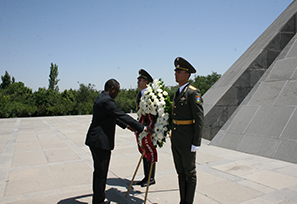
Rwandan Foreign Minister Vincent Biruta visited the Armenian Genocide Memorial
11.07.2022
The delegation led by the Rwandan Minister of Foreign Affairs, Vincent Biruta, who arrived in Armenia on a two-day visit, visited the Armenian Genocide Memorial accompanied by the Mnatsakan Safaryan, RA Deputy Foreign Minister, on July 11.
AGMI Director Harutyun Marutyan welcomed the guests and told them the history of the creation of the memorial. He also related the story of the three khachkars placed in Tsitsernakaberd Park dedicated to the memory of the Armenians who perished during the ethnic cleansing of the Armenian population within Azerbaijan at the end of the last century.
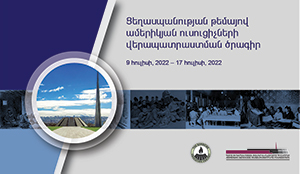
OTRAINING PROGRAMME FOR AMERICAN TEACHERS
09.07.2022
The American "Genocide Education Project" organisation, in cooperation with the Armenian Genocide Museum-Institute, is organising a training programme for American teachers on July 9-17, 2022.
The course, which will take place between July 10th and 15th in the Armenian Genocide Museum-Institute’s conference hall using a lecture-practical format, will present the participants with the historical, legal and socio-psychological perspectives of the Armenian Genocide, while showing the long-term influence of the impunity enjoyed by this crime and its impact on the current political and economic situation of the Republic of Armenia. A separate session will be dedicated to the Artsakh issue.
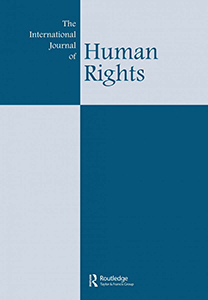
On the route to the internationalisation of Armenian Genocide studies
09.07.2022
The work carried out by AGMI researchers is being published both in Armenian and international scientific journals, books and collected works. From now on, we will regularly present their articles on the Armenian Genocide and the Armenian Question published in journals included in international scientific databases (WOS, Scopus, Book Citation Index).
Dr. Edita Gzoyan, Deputy Scientific Director of the Armenian Genocide Museum-Institute and Regina Galustyan, AGMI researcher, have published an article titled "Forced Marriages as a Tool of Genocide: the Armenian Case" in the monthly journal “The International Journal of Human Rights” (WOS, Q2). The article provides an overview of the development of the concept of forced marriage in international criminal law and focuses on the forced marriages organised during the Armenian Genocide.
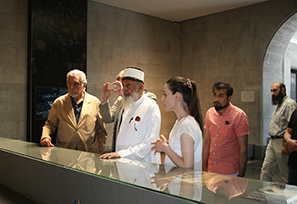
Sheikh Imran Hosein visited the Armenian Genocide Museum
07.07.2022
Sheikh Imran Hussein, the famous philosopher and lecturer who lives in Belgium, visited the Armenian Genocide Museum on July 7.
The guest was welcomed by Lusine Abrahamyan, AGMI Deputy Director for Museum Affairs, who briefly presented the Sheikh with the history of the creation of the Armenian Genocide Memorial and Museum.
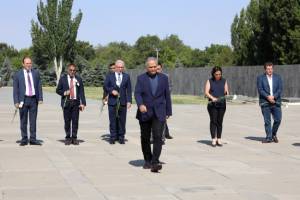
Indian Secretary (West) Sanjay Verma visited the Armenian Genocide Memorial
05.07.2022
On July 5, the delegation led by the Secretary (West) of the Ministry of Foreign Affairs of the Republic of India Sanjay Verma, who arrived in Armenia to participate in the 8th session of the Armenian-Indian Intergovernmental Commission, visited the Armenian Genocide Memorial accompanied by RA Deputy Foreign Minister Mnatsakan Safaryan and the Extraordinary and Plenipotentiary of India in Armenia Dhan Deval.
The guests were welcomed by the Deputy Scientific Director of the Armenian Genocide Museum-Institute Edita Gzoyan, who presented the history of the Genocide Monument creation. Edita Gzoyan also presented important facts from the history of the Armenian Genocide.
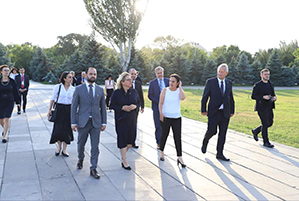
German Federal Minister of Economic Cooperation and Development Svenja Schulze visited the Armenian Genocide Memorial
01.07.2022
On June 30, the delegation headed by the Federal Minister of Economic Cooperation and Development of the Federal Republic of Germany Svenja Schulze, who arrived in Armenia on a two-day visit, visited the Armenian Genocide Memorial, accompanied by the Deputy Minister of Economy of Armenia Armen Arzumanyan, the Ambassador Extraordinary and Plenipotentiary of Germany to Armenia Victor Richter and the Ambassador Extraordinary and Plenipotentiary of Armenia to Germany Victor Yengibaryan.
The guests were welcomed by the Deputy Scientific Director of the Armenian Genocide Museum-Institute Edita Gzoyan, who presented the story of the 3 khachkars placed in Tsitsernakaberd Park and dedicated to the memory of the Armenians who perished during the ethnic cleansing of the Armenian population within Azerbaijan at the end of the last century.
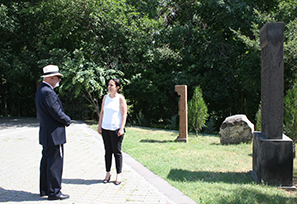
The newly appointed Ambassador of Israel to Armenia, Joel Lion, visited the Armenian Genocide Memorial
30.06.2022
On June 30, the newly appointed Ambassador of the State of Israel to Armenia, Joel Lion (residence in Jerusalem), visited the Armenian Genocide Memorial, accompanied by Honorary Consul of Israel in Armenia, Ashot Shakhmuradyan.
The guests were welcomed by the Deputy Scientific Director of the Armenian Genocide Museum-Institute Edita Gzoyan, who presented the story of the 3 khachkars placed in Tsitsernakaberd Park and dedicated to the memory of the Armenians who perished during the ethnic cleansing of the Armenian population within Azerbaijan at the end of the last century.
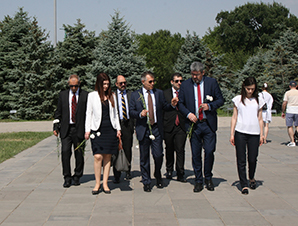
State Secretary of the Ministry of Foreign Affairs of the Republic of Serbia Nemanja Starović visited the Armenian Genocide Memorial
30.06.2022
On June 30, the delegation led by the State Secretary of the Ministry of Foreign Affairs of the Republic of Serbia, Nemanja Starović, who arrived in Armenia on a working visit, visited the Armenian Genocide Memorial, accompanied by Ara Margaryan, Head of the European Department of the RA MFA, and the Ambassador Extraordinary and Plenipotentiary of Serbia to the Republic of Armenia Mrs. Tatjana Panajotovic Cvetkovic.
The guests were welcomed by the AGMI Deputy Director for Museum Affairs Lusine Abrahamyan, who presented the history of the creation of the Memorial. She also related the story of the 3 khachkars placed in Tsitsernakaberd Park and dedicated to the memory of the Armenians who perished during the ethnic cleansing of the Armenian population within Azerbaijan at the end of the last century.
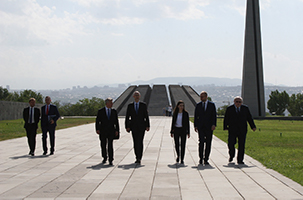
Polish Deputy Foreign Minister Marcin Przydacz visited the Armenian Genocide Memorial
28.06.2022
The delegation led by the Deputy Minister of Foreign Affairs of the Republic of Poland Marcin Przydacz, who arrived in Armenia on a working visit, visited the Armenian Genocide Memorial on June 28 accompanied by the Ambassador Extraordinary and Plenipotentiary of Poland to the Republic of Armenia Pavel Cheplak.
The guests were welcomed by the AGMI Deputy Director for Museum Affairs Lusine Abrahamyan, who presented the history of the creation of the Memorial. She also related the story of the 3 khachkars placed in Tsitsernakaberd Park and dedicated to the memory of the Armenians who perished during the ethnic cleansing of the Armenian population within Azerbaijan at the end of the last century.
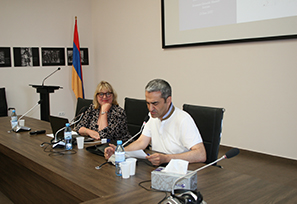
AGMI PUBLIC LECTURE
24.06.2022
Professor Elisa von Joeden-Forgey, Chair of Holocaust and Genocide Studies at Keene State College, New Hampshire, delivered a public lecture on “Genocide as Reproductive Violence” in the Armenian Genocide Museum-Institute conference hall on June 23.
Suren Manukyan, head of the AGMI V. Dadryan Department of Comparative Genocide Studies, greeted the participants and briefly presented Elisa von Joeden-Forgey’s biography and scholarly activities, noting that she was the founder of the academic credit program for Genocide Prevention in New Jersey’s Stockton University, president of “Genocide Watch” and the first vice-president of the International Association of Genocide Scholars.
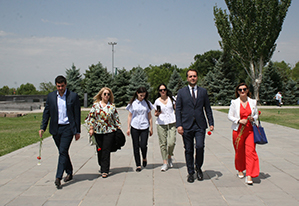
The Greek deputies visited the Armenian Genocide Memorial
24.06.2022
The deputies of the Greek Parliament, who arrived in Armenia on a working visit, visited the Armenian Genocide Memorial on June 24 accompanied by the Chairman of the RA NA Standing Committee on European Integration Arman Yeghoyan.
The guests were welcomed by the AGMI Deputy Director for Museum Affairs Lusine Abrahamyan, who presented the history of the creation of the Memorial. She also related the story of the 3 khachkars placed in Tsitsernakaberd Park and dedicated to the memory of the Armenians who perished during the ethnic cleansing of the Armenian population within Azerbaijan at the end of the last century.
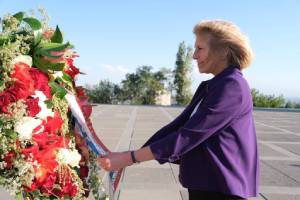
US Assistant Secretary of State Karen Donfried visited the Armenian Genocide Memorial
18.06.2022
The delegation led by US Assistant Secretary of State for European and Eurasian Affairs Karen Donfried visited the Armenian Genocide Memorial on June 18 accompanied by RA Deputy Foreign Minister Paruyr Hovhannisyan and U.S. Ambassador to Armenia Lynne Tracy.
The guests were welcomed by the Deputy Scientific Director of the Armenian Genocide Museum-Institute Edita Gzoyan, who presented the story of the 3 khachkars placed in Tsitsernakaberd Park and dedicated to the memory of the Armenians who perished during the ethnic cleansing of the Armenian population within Azerbaijan at the end of the last century. Edita Gzoyan also touched upon the historical and legal aspects of the Artsakh issue, and presented Azerbaijan's anti-Armenian actions and propaganda.
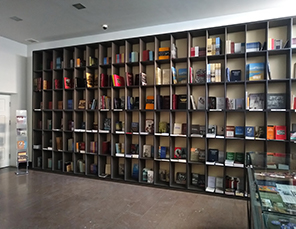
The Armenian Genocide Museum-Institute’s “World of Books”
17.06.2022
The Armenian Genocide Museum has been operating a bookstore for more than twenty years, selling books and journals published by the AGMI as well works by individual scholars from other Armenian and foreign scientific centres, mostly concerning the Armenian Genocide. They mainly have the following content:
• Eyewitness memoirs by survivors of the Armenian Genocide
• Testimonies to the Armenian Genocide by diplomatic representatives, missionaries and travellers from different countries
• Scientific works on the Armenian-populated regions of western Armenia and the Ottoman Empire
• Studies of source value, enriched with archival documents, concerning individual episodes of the Armenian Genocide.
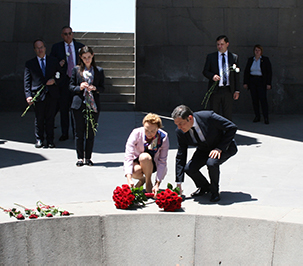
Secretary General of the Council of Europe Marija Pejčinović Burić visited the Armenian Genocide Memorial
16.06.2022
The delegation led by the Secretary General of the Council of Europe Marija Pejčinović Burić, who arrived in Armenia on an official visit, visited the Armenian Genocide Memorial on June 16 accompanied by the RA Deputy Foreign Minister Paruyr Hovhannisyan.
The guests were welcomed by the AGMI Deputy Director for Museum Affairs Lusine Abrahamyan, who presented the history of the memorial, as well as, the history of the memorial and the history of the creation of the Memorial. She also related the story of the 3 khachkars placed in Tsitsernakaberd Park and dedicated to the memory of the Armenians who perished during the ethnic cleansing of the Armenian population within Azerbaijan at the end of the last century.
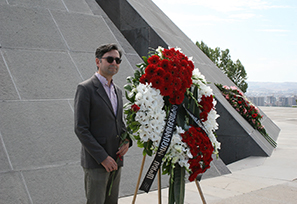
Nobel Laureate in Healthcare and Physiology Ardem Pataputyan visits Armenian Genocide Memorial
16.06.2022
Armenian scientist, Nobel Laureate in Health and Physiology, Professor Ardem Pataputyan visited the Armenian Genocide Memorial on June 16. The guests were welcomed by the Deputy Scientific Director of the Armenian Genocide Museum-Institute Edita Gzoyan, who presented the history of the memorial and the history of the creation of the Memorial. She also related the story of the 3 khachkars placed in Tsitsernakaberd Park and dedicated to the memory of the Armenians who perished during the ethnic cleansing of the Armenian population within Azerbaijan at the end of the last century.
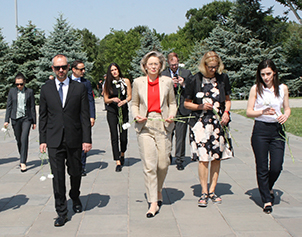
OSCE PA President Margareta Cederfelt visits Armenian Genocide Memorial
15.06.2022
The delegation led by Margareta Cederfelt, President of the Parliamentary Assembly of the Organization for Security and Co-operation in Europe (OSCE), who arrived in Armenia on a working visit, visited the Armenian Genocide Memorial on June 15 accompanied by Eduard Aghajanyan, Chairman of the RA NA Standing Committee on Foreign Relations.
The guests were welcomed by the AGMI Deputy Director for Museum Affairs Lusine Abrahamyan, who presented the history of the memorial, as well as, the history of the memorial and the history of the creation of the Memorial. She also related the story of the 3 khachkars placed in Tsitsernakaberd Park and dedicated to the memory of the Armenians who perished during the ethnic cleansing of the Armenian population within Azerbaijan at the end of the last century.
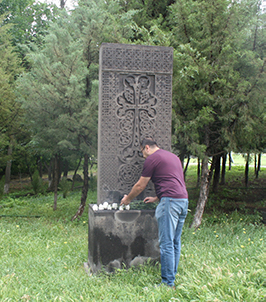
Shahumyan without Armenians for 30 years
14.06.2022
A round table meeting, dedicated to the 30th anniversary of the depopulation of Armenians from the Shahumyan region, took place in the conference hall of the Armenian Genocide Museum-Institute on June 14. A group of former Shahumyan residents, historians and AGMI staff laid flowers, first thing in the morning, at the khachkars erected on Tsitsernakaberd Hill in memory of the victims of Armenians’ massacres in Sumgait, Gandzak and Baku.
This round table meeting dedicated to the 30th anniversary of the eviction of the Armenians from the Shahumyan region began with an opening speech by Edita Gzoyan, AGMI Deputy Director for Scientific Works. She stressed the importance of the organisation of such an event as a step towards the study of the repression suffered by the Armenians of Artsakh, Nakhichevan, Azerbaijan and their internationalisation, describing Azerbaijan’s state anti-Armenian policy as the as a continuation of Turkish genocidal policy.
The participants were then greeted by Mariam Avagyan, Associate Professor and Coordinator of the Refugees’ from the Azerbaijani SSR Assembly, who gave a speech on “The deportation of the Armenians from the Shahumyan region in Armenian-populated areas under Azerbaijani control is an Armenian Genocide episode”.
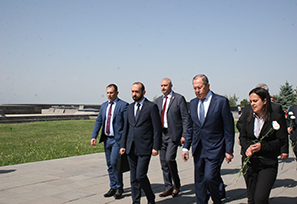
MFA RF Sergey Lavrov visited the Armenian Genocide Memorial
09.06.2022
On 9 June, the Russian Foreign Minister Sergey Lavrov, who arrived in Armenia on a working visit, visited the Armenian Genocide Memorial accompanied by the Armenian Foreign Minister Ararat Mirzoyan.
The guests were welcomed by the Deputy Scientific Director of the Armenian Genocide Museum-Institute Edita Gzoyan.
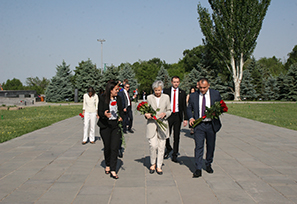
The chairman of the Venice Commission, Claire Bazy Mallory, visited the Armenian Genocide Memorial
09.06.2022
The delegation led by the newly elected President of the European Commission “Democracy through Law” (Venice Commission) Mrs. Claire Bazy Mallory, who arrived in Armenia on an official visit, visited the Armenian Genocide Memorial on June 9 accompanied by the President of the RA Constitutional Court Arman Dilanyan.
The guests were welcomed by the Deputy Scientific Director of the Armenian Genocide Museum-Institute Edita Gzoyan, who presented the history of the memorial and the history of the creation of the Memorial. She also related the story of the 3 khachkars placed in Tsitsernakaberd Park and dedicated to the memory of the Armenians who perished during the ethnic cleansing of the Armenian population within Azerbaijan at the end of the last century.
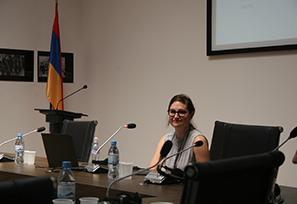
A Lecture at the AGMI
Historical episodes through individual objects
04.06.2022
The AGMI hosted a lecture given by Stacey Worster, Lecturer at the University of Amsterdam. in its conference hall on May 31 titled “Legends of the Artefacts: Object-Centric Research, Education and Public Engagement.”
Stacey Worster is from South Africa and studied art history at the University of Witwatersrand in Johannesburg. From 2012-2016 she worked as a curator of the Republic of South Africa’s Constitutional Court’s collection, then continued her studies at the University of Amsterdam, where she now works.
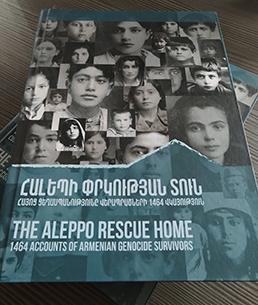
THE ALEPPO RESCUE HOME: 1464 ACCOUNTS OF ARMENIAN GENOCIDE SURVIVORS
Book Presentation at the AGMI
03.06.2022
The presentation of the book “The Aleppo Rescue Home: 1464 Accounts of Armenian Genocide Survivors” by Edita Gzoyan Ph.D., AGMI Deputy Director for Scientific Works, took place in the Armenian Genocide Museum-Institute conference hall on 2nd June.
The work puts 1464 stories of Armenian Genocide survivors, held in the archives of the League of Nations (Geneva, Switzerland), into circulation in their original English with an Armenian translation and corrected toponyms, footnotes and photographs of survivors. The latter were rescued, through the efforts of Karen Jeppe, the Danish missionary and League of Nations Commissioner, finding refuge in the Aleppo Rescue House.
AGMI Director Harutyun Marutyan greeted the participants with an opening speech and stressed the importance of the great work carried out by Edita Gzoyan, mentioning that the research carried out is unique in that the horrors suffered by the most vulnerable group, women and children, are presented through documents held in the archives of the League of Nations, which was the most important international organization of the time.
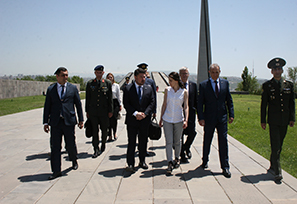
Greek Deputy Defense Minister Chardalias Nikos visited the Armenian Genocide Memorial
02.06.2022
The delegation of the Ministry of National Defense of the Hellenic Republic headed by the Deputy Minister of National Defense Chardalias Nikos, who arrived in Armenia on a working visit, visited the Armenian Genocide Memorial on June 2.
The guests were welcomed by the AGMI Deputy Director for Museum Affairs Lusine Abrahamyan, who presented the history of the memorial.
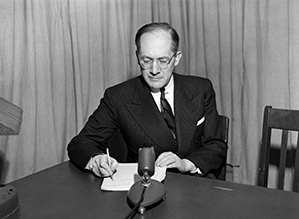
AGMI FOUNDATION ANNOUNCES 2022 LEMKIN SCHOLARSHIP FOR FOREIGN RESEARCHERS
31.05.2022
The Armenian Genocide Museum-Institute foundation announces 2022 LEMKIN SCHOLARSHIP program for foreign young researchers and PhD candidates. Raphael Lemkin scholarship is intended to extend research on the Armenian Genocide, promote multilayered research of the theme and engage young scientists.
The program will enable one up to 40-year-old foreign PhD students or young researchers who specialize in the field of genocide research and work on their doctoral thesis, to spend one month in Armenia and conduct their research at the archives of the Armenian Genocide Museum-Institute, as well as other local scientific institutions and libraries.
Dear visitor,
The museum will be closed on May 28.
Sincerely,
The Armenian Genocide Museum-Institute Foundation
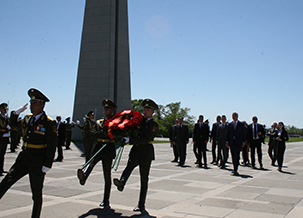
President of Montenegro Milo Đukanović visited the Armenian Genocide Memorial
26.05.2022
On May 26, President of Montenegro Milo Đukanović, who arrived in Armenia on an official visit, visited the Armenian Genocide Memorial accompanied by Yerevan Mayor Hrachya Sargsyan and RA Minister of Economy Vahan Kerobyan.
The guests were welcomed by the AGMI Deputy Director for Museum Affairs Lusine Abrahamyan, who presented the history of the memorial.
Milo Đukanović laid a wreath at the Genocide Monument, and then the accompanying guests put flowers at the Eternal Fire and honored the memory of innocent martyrs with a minute of silence.
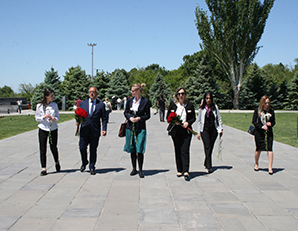
Executive Director of the International Alliance for the Protection of Heritage in Conflict Areas, Valéry Freeland and Program Officer of the Alliance Elsa Urizveryan visited the Armenian Genocide Memorial
26.05.2022
On May 26, Executive Director of the International Alliance for the Protection of Heritage in Conflict Areas (ALIPH) Valéry Freeland and Program Officer Elza Urizveryan visited the Armenian Genocide Memorial, accompanied by Nune Zastukhova, Head of the Department of Multilateral Policy and Development Cooperation of the Ministry of Foreign Affairs of the Republic of Armenia.
The guests were welcomed by the AGMI Deputy Director for Museum Affairs Lusine Abrahamyan, who presented the history of the memorial.
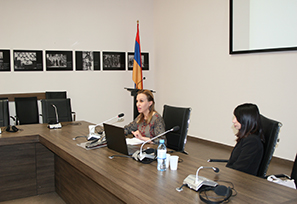
Commemoration of the victims of the Pontic Greek Genocide at the AGMI
21.05.2022
The Parliament of the Hellenic Republic of Greece declared, on February 24, 1994, that May 19 is a day of remembrance for the victims of the Greek Genocide, associated with the arrival of Mustafa Kemal in Samsun. The Greek Genocide is also commemorated on September 14 in connection with the premeditated extermination of the Smyrna Christians, followed by the burning of that city, in 1922.
A discourse, dedicated to the memory of the victims of the Pontic Greek Genocide, was held in the "Armenian Genocide Museum-Institute" Foundation’s conference hall on May 21 in the presence of Harutyun Marutyan, AGMI Director, Edita Gzoyan, AGMI Deputy Scientific Director, Maria Lazareva, President of the Union of Greek Communities of Armenia, Garnik Harutyunyan, President of TheoLab Scientific-Analytical Centre and it’s co-founder Hayk Hakobyan, as well as representatives of the Greek community.
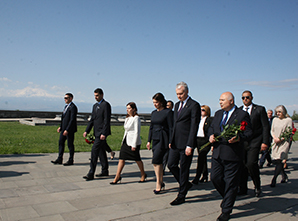
Lithuanian President Gitanas Nausėda visited the Armenian Genocide Memorial
20.05.2022
The President of the Republic of Lithuania Gitanas Nausėda, who arrived in Armenia on an official visit, visited the Armenian Genocide Memorial with his wife Diana Nausediene, and accompanied by Yerevan Mayor Hrachya Sargsyan and RA Minister of Health Anahit Avanesyan on May 20.
AGMI Director Harutyun Marutyan welcomed the guests and told them the history of the creation of the Memorial. He also related the story of the 3 khachkars placed in Tsitsernakaberd Park and dedicated to the memory of the Armenians who perished during the ethnic cleansing of the Armenian population within Azerbaijan at the end of the last century.
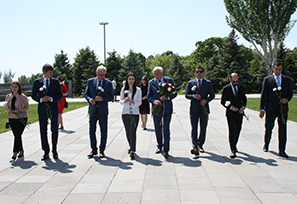
The First Vice President of the Czech Senate Jiri Ruzicka visited the Armenian Genocide Memorial
18.05.2022
The delegation led by the First Deputy Speaker of the Czech Senate Jiri Ruzicka, who arrived in Armenia on a working visit, visited the Armenian Genocide Memorial on May 18 accompanied by RA NA Deputy Speaker Hakob Arshakyan and Head of the Armenia-Czech Republic Friendship Group Arthur Hovhannisyan.
The guests were greeted by Lusine Abrahamyan, the Armenian Genocide Museum-Institute’s Deputy Director for Museum Works, who presented the history of the memorial.
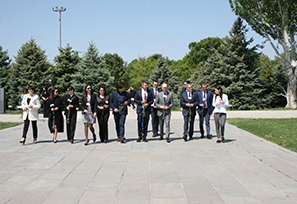
The Italian parliamentarians visited the Armenian Genocide Memorial
18.05.2022
On May 18, the delegation of the Italian Parliament visited the Armenian Genocide Memorial accompanied by a group of RA NA deputies and Alfonso Di Rizzo, Ambassador Extraordinary and Plenipotentiary of Italy to the RA.
The guests were welcomed by Lusine Abrahamyan, Deputy Director for Museum Affairs of the Armenian Genocide Museum-Institute, who presented the history of the memorial.
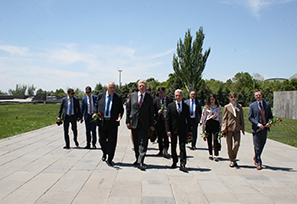
The President of the Audit Chamber of the Russian Federation Alexei Kudrin visited the Armenian Genocide Memorial
14.05.2022
The delegation led by the Chairman of the Audit Chamber of the Russian Federation Alexei Kudrin, who arrived in Armenia on a working visit, visited the Armenian Genocide Memorial on May 14 accompanied by the Chairman of the Audit Chamber of the Republic of Armenia Atom Janjughazyan.
AGMI Director Harutyun Marutyan welcomed the guests and told them the history of the creation of the Memorial. He also related the story of the 3 khachkars placed in Tsitsernakaberd Park and dedicated to the memory of the Armenians who perished during the ethnic cleansing of the Armenian population within Azerbaijan at the end of the last century.
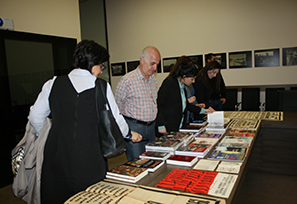
Uruguayan Armenian community to the Armenian Genocide Museum
13.05.2022
A number of important materials - brochures, leaflets and books on the history of Armenia, the Armenian Cause and the Armenian Genocide – were presented to the Armenian Genocide Museum-Institute by the Armenian community of Uruguay. This took place in the Armenian Genocide Museum’s conference hall on May 12 this year. It was attended by Eduardo Rosenbrock, Ambassador of the Eastern Republic of Uruguay to the Republic of Armenia and his wife.
The donors of the materials handed over to the AGMI Foundation by our compatriots living in Uruguay were Mrs. Nairi Aharonian, the Aharonian-Paraskevaides’ archive director, Professor Eduardo Alvarez Petrosian and Dr. Carlos Getsoian.
In his opening speech, AGMI Director Harutyun Marutyan highlighted Uruguay’s role on behalf of the Armenian people, being the first government to recognize the Armenian Genocide. He added: “After the recognition of the Armenian Genocide by Uruguay, a number of major countries of the world followed the big step taken by this small state by also recognising it. All these materials passed to us today by Uruguay’s Armenian community of are of great significance for our museum.”
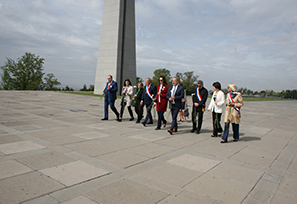
French delegation visited the Armenian Genocide Memorial complex
03.05.2022
Arriving in Armenia, the delegation led by the head of the France-Armenia Friendship Group of the French Senate, Gilbert-Luc Devinaz, visited the Armenian Genocide Memorial complex, accompanied by the head of the Armenia-France Friendship Group of the RA NA Vladimir Vardanyan, on May 3, 2022.
The guests were greeted by Lusine Abrahamyan, the Armenian Genocide Museum-Institute’s Deputy Director for Museum Works, who presented the history of the memorial.
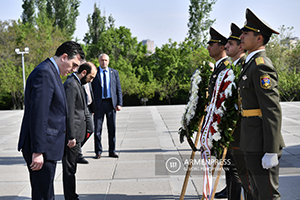
Ilia Darchiashvili, Georgian Deputy Prime Minister and Foreign Minister, visited the Armenian Genocide Memorial complex
30.04.2022
The delegation, headed by Georgian Deputy Prime Minister and Foreign Minister Ilia Darchiashvili, who arrived in Armenia on an official visit, visited the Armenian Genocide Memorial complex, accompanied by the Minister of Foreign Affairs of the Republic of Armenia Ararat Mirzoyan, on April 30, 2022.
The guests were welcomed by the director of the Armenian Genocide Museum-Institute Harutyun Marutyan.
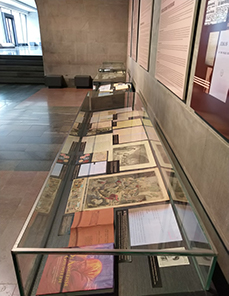
“The horrors suffered by the Armenians as seen through Dutch eyes”
The opening of a new temporary exhibition in the AGMI
29.04.2022
A temporary exhibition titled "The horrors suffered by the Armenians as seen through Dutch eyes" was opened in the AGMI’s small exhibition hall today, April 29, 2022. This unique exhibition addresses the Dutch response to the Armenian massacres and Genocide for the first time.
The exhibition was opened with a welcoming speech made by the director of the “Armenian Genocide Museum-Institute” Foundation Harutyun Marutyan, after which Dr. Dirk Roodzant, the exhibition’s creator, greeted those present.
The opening ceremony was also attended by the Ambassador of the Kingdom of the Netherlands to the Republic of Armenia Mr. Nicholas Jacob Schermers, the US Deputy Ambassador to the Republic of Armenia Mr. Chip Leitinen and the Director of the Archives and Museums of the Mother See of Holy Etchmiadzin, Father Asoghik Karapetyan.
The bilingual (Armenian and English) temporary exhibition, consisting of four titled sections, features original documents, illustrations and unique examples of items concerning the Armenian Genocide, published in the Dutch press, which are being exhibited for the first time. Most of the materials presented are from the Dutch researcher and creator of the exhibition Dr. Dirk Rhoodzant’s personal collection.
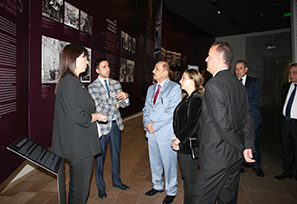
Members of legislative and executive bodies of several countries visited the Armenian Genocide Museum
24.04.2022
Members of the legislative and executive bodies of a number of countries also paid tribute to the memory of the Armenian Genocide victims at Tsitsernakaberd this morning.
The parliamentarians of the Syrian Arab Republic, the Hashemite Kingdom of Jordan, the mayor of the Norwegian city of Kragerø, the Norwegian ambassador to Armenia, the members of the Israeli Knesset and members of the Dutch governmental delegation also visited the Armenian Genocide Museum.
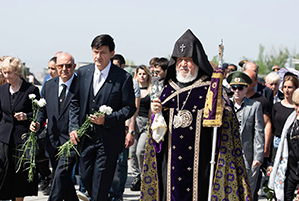
The Catholicos of All Armenians visited the Armenian Genocide Memorial
24.04.2022
On April 24, His Holiness Garegin II, Supreme Patriarch and Catholicos of All Armenians, accompanied by members of the order of the Mother See of Holy Etchmiadzin, visited the Tsitsernakaberd Memorial to commemorate the holy martyrs of the Armenian Genocide.
After laying of his wreath at the memorial, the holy martyrs intercession ceremony of the Armenian Genocide was held under the presidency of His Holiness before the Eternal Flame.
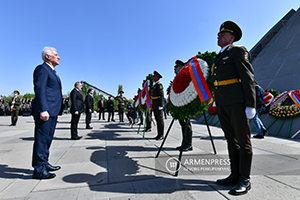
High-ranking statesmen of the Republic of Armenia paid tribute to the memory of the victims of the Armenian Genocide
24.04.2022
Republic of Armenia President Vahagn Khachaturyan, Prime Minister Nikol Pashinyan, National Assembly Speaker Alen Simonyan, National Assembly deputies, members of the government, the heads of diplomatic missions accredited to Armenia and others paid tribute to the memory of the Armenian Genocide victims at Tsitsernakaberd Memorial.
High-ranking officials put flowers at the Eternal Flame and honoured the memory of the innocent martyrs with a minute’s silence.
After the visit to the memorial, the statesmen, led by the RA Prime Minister visited the Armenian Genocide Museum.
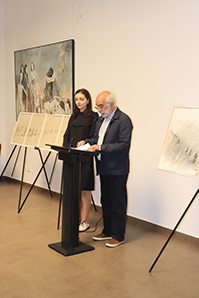
THE CONCEPT OF “RETURN” IN JEAN-PIERRE SEFERIAN’S ENGRAVED WORKS WITH THE THEME OF “DEATH MARCH”
23.04.2022
The French-Armenian artist and engraver Jean-Pierre Seferian’s exhibition titled “DESERT: THE DEATH MARCH” was opened in the AGMI Gallery on April 23.
AGMI Deputy Director for Scientific Works, Edita Gzoyan gave the opening speech. In his speech, Jean-Pierre Seferian thanked AGMI Director Harutyun Marutyan, as well as the entire AGMI staff. Tehmine Martoyan, senior researcher in the Armenian Genocide Victims’ Documentation and Data Collection Department, greeted those present.
Jean-Pierre (Haroutioun-Bedros) Seferian was born in Marseilles on January 10, 1954. His father was originally from Sebastia (Sivas) and his mother from Ankara. They emigrated to France in 1925. Settling in the suburb of Issy-les-Moulineaux near Paris, Jean-Pierre Seferian decided, at the age of 18, to specialise in graphic art and advertising. He started working in studios and advertising agencies and, at the same time graduated from the School of Applied Arts in Paris (by evening classes, in 1975) and studied painting techniques at the School of Fine Arts (1976).
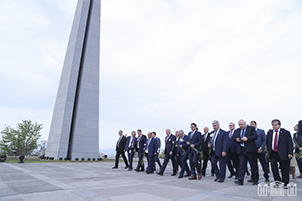
Members of the Republic of Armenia National Assembly and Russian Federation Interparliamentary Cooperation Committee visit the Armenian Genocide Memorial
23.04.2022
Members of the RA NA and RF Inter-Parliamentary Cooperation Committee visited the Armenian Genocide Memorial accompanied by the RA NA Deputy Speaker Hakob Arshakyan, the Russian Ambassador to Armenia Sergei Kopyrkin, the RA Ambassador to Russia Vagharshak Harutyunyan on April 23.
AGMI Director Harutyun Marutyan welcomed the guests and told them the history of the creation of the Memorial. He also related the story of the 3 khachkars placed in Tsitsernakaberd Park and dedicated to the memory of the Armenians who perished during the ethnic cleansing of the Armenian population within Azerbaijan at the end of the last century.
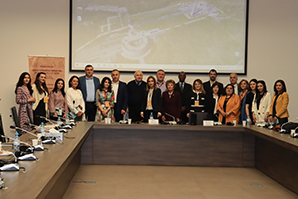
THE THREE-DAY INTERNATIONAL CONFERENCE TITLED "ARMENIAN GENOCIDE TEACHING CHALLENGES IN THE 21ST CENTURY" HAS TAKEN PLACE
23.04.2022
A three-day conference titled “Challenges of Teaching the Armenian Genocide in the 21st Century” organised by the Armenian Genocide Museum-Institute Foundation took place from April 20 to 22, 2010.
AGMI Director Harutyun Marutyan made an opening speech at the conference. A welcoming speech was also delivered by Republic of Armenia Deputy Minister of Education and Science Janna Andreasyan.
A temporary exhibition titled “Tracing the Armenian Schools in the Ottoman Empire: An Enlighted Nation’s Certificates” organised by the Armenian Genocide Museum-Institute Foundation was opened on the first day of the conference.
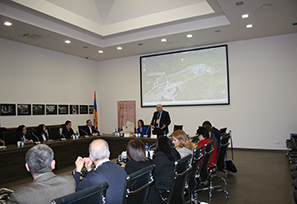
OPENING OF THE INTERNATIONAL CONFERENCE AND TEMPORARY EXHIBITION AT THE ARMENIAN GENOCIDE MUSEUM-INSTITUTE
20.04.2022
A three-day conference organized by the Armenian Genocide Museum-Institute Foundation and titled “Challenges of Teaching the Armenian Genocide in the 21st Century” was launched today in its conference hall.
AGMI Director Harutyun Marutyan made the opening speech, saying, among other things: “We have realised that there is a problem, in terms of methodology, for teachers and ourselves and this conference is called upon to address it. This is probably the first such conference in the Armenian reality. Through discussions with authoritative scholars from abroad, we want to get an idea of how the subject of genocide is taught in foreign countries in both Armenian and non-Armenian environments, given the fact that the foreign experts here represent mainly nations that have been subject to genocide at different times.”
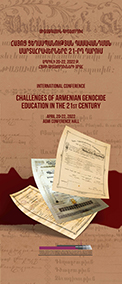
PRESS RELEASE
16.04.2022
The opening ceremony of the three-day conference entitled “Challenges of Teaching the Armenian Genocide in the 21st Century” organized by the Armenian Genocide Museum-Institute Foundation will take place on April 20, at 09:30, in the conference hall of the Armenian Genocide Museum-Institute. About thirty specialists in the field of genocide studies and related fields from Armenia, the United States, the Russian Federation, Lebanon, Israel, Rwanda, Spain, the Republic of South Africa and Cambodia will take part in the conference.
The opening ceremony will be followed by the opening of a temporary exhibition entitled “Tracing the Armenian Schools in the Ottoman Empire: An Enlighted Nation’s Certificates”, organized by the Armenian Genocide Museum-Institute Foundation (at 10:15), which is the first thematically and has a purpose, that is, to raise and present from a distance of more than a century the once fruitful activities of about 2000 Armenian schools in Western Armenia, Cilicia, in the Armenian-populated areas of the Ottoman Empire, which was interrupted by the Armenian Genocide. These institutions, despite the persecution and violence perpetrated by the Ottoman government, not only did not cease to exist, but also had great success for decades, making significant contributions to the empire's education, science, and cultural development.
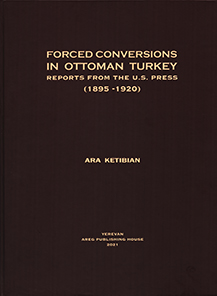
PRESS RELEASE
13.04.2022
The presentation of a new book, “Forced Conversions in Ottoman Turkey: Reports from The U.S. Press (1895-1920)”, by Ara Ketibian, the Australian-Armenian literary critic and co-author of the multi-volume book “The Armenian Genocide: Prelude and Aftermath. As reported in the U.S. Press” will take place on April 15 at 2:30 pm in the conference hall of the Armenian Genocide Museum-Institute.
The author of the book Ara Ketibian will be present at the presentation.
The entrance is free.
We look forward to see you.
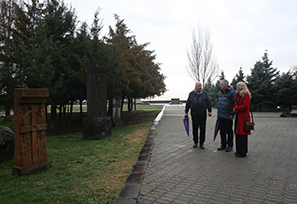
Member of the House of Lords and Adviser to UK Government on Antisemitism John Mann Visited the Armenian Genocide Memorial
08.04.2022
Member of the House of Lords of the United Kingdom and adviser to UK Government on Antisemitism John Mann, who was in Armenia on a working visit, visited the Armenian Genocide Memorial on April 8.
The delegation was welcomed by the Director of the Armenian Genocide Museum-Institute Mr. Harutyun Marutyan, who recounted the history of the memorial complex to the guests. Mr. Marutyan also told them the history of the 3 khachkars placed in the grounds of Tsitsernakaberd, dedicated to the memory of the Armenians who died during the ethnic cleansing of the Armenian population in Azerbaijan at the end of the last century.
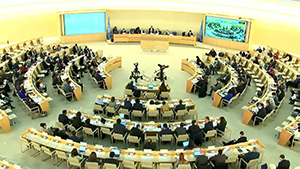
During the 49th session of the UN Human Rights Council the resolution on "Prevention of Genocide" initiated by Armenia was adopted by consensus
01.04.2022
On March 31, during the 49th session of the UN Human Rights Council (28 February – 1 April 2022), the resolution on "Prevention of Genocide" initiated by Armenia was adopted by consensus.
The resolution assessing current threats and challenges, outlines the steps to be taken jointly by the UN member states towards prevention of the calamity of genocide, its recognition, restoration of justice, compensation, punishment and ensuring the accountability of the genocide perpetrators.
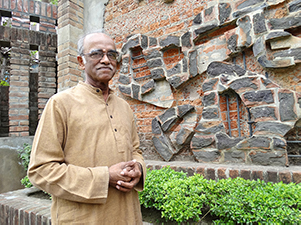
The Bangladesh Genocide-1971
25.03.2022
March 25 is the Bengali Genocide Remembrance Day, which commemorates the victims of the 1971 genocide in Bangladesh. And in this regard, we talked to a bengali genocide scholar Mofidul Hoque․
With the launch of a military "Operation Searchlight" in Eastern Pakistan (Bangladesh) on March 25, Pakistan aimed to suppress Bangladesh's right to self-determination. Pakistan's actions lead to genocide, causing many deaths. March 25 is the Day of Commemoration of the Bangladesh genocide when Bengali people commemorate the victims of the 1971 massacres. What kind of official commemoration ceremonies are held in Bangladesh on March 25.
- Pakistan, since its inception in 1947, has established a domination of Western part over the Eastern wing, that started with the denial of language right and took the form of cultural, economic, administrative and political domination.
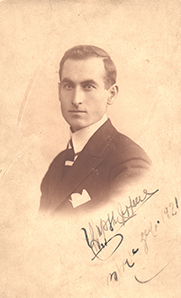
SOGHOMON TEHLIRIAN: THE ASSASSINATION OF TALAT
15.03.2022
After the defeat of the Ottoman Empire in World War I, its new government decided, under pressure from the Allies, to prosecute members of the Young Turk government and the central committee of the Union և Progress Party for dragging the Ottoman Empire into the war and organising the deportation and massacre of the Armenians. The main group of culpable Young Turks (Mehmet Talat, Ismail Enver, Ahmed Cemal, Behaeddin Shakir, Mehmet Nazim, Osman Bedri and Hussein Azmi) had, however, already escaped responsibility and criminal arrest by leaving on a German warship on November 1, 1918.
In autumn 1919, the 9th general assembly of the Armenian Revolutionary Federation (ARF) in Yerevan, set up, in conditions of the strictest secrecy, a special mission (Hatuk Gortz) under the leadership of Armen Garo, (RA Ambassador to the United States), tasked with finding and suitably punishing the Young Turk organisers and perpetrators of the Armenian Genocide.
Soghomon Tehlirian (1896-1960) is rightly considered to be the most famous figure in the special operational group (operation “Nemesis”) and may be considered as a symbol of Armenian revenge. This is due not only to the fact that his target was that most famous criminal, Talat, but also because his trial was widely publicised.
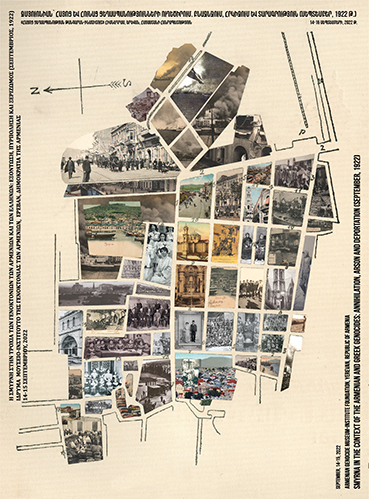
CONFERENCE INVITATION
02.03.2022
Title: Smyrna in the Context of the Armenian and Greek Genocides: Annihilation, Arson and Deportation (September 1922)
Date: September 14-15, 2022
Location: Armenian Genocide Museum-Institute, Yerevan, Republic of Armenia
Organised by: Armenian Genocide Museum-Institute Foundation
Co-organisers: YSU Institute of Armenian Studies, Khachatur Abovyan Armenian State Pedagogical University, Haigazian University of Beirut (Lebanon), Aristotle University of Thessaloniki (Greece)
September 2022 marks the 100th anniversary of the last stage of the Armenian and Greek genocides with the massacre of the Greek and Armenian populations of Smyrna and the premeditated arson of the Armenian and Greek quarters of the city.
Smyrna, with its multinational and multicultural existence, greatly contributed to the development of the Armenians, Greeks and foreigners living in Smyrna. The city’s Greek community developed thanks to the initiatives of hundreds of local Greeks and others from Greece, focusing on cultural development, education, the role of the church.
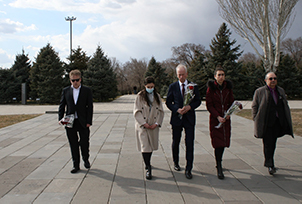
Canada’s Special Envoy to the European Union and Europe, Ambassador Extraordinary and Plenipotentiary to the Federal Republic of Germany Stéphane Dion visits the Armenian Genocide Memorial
01.03.2022
The delegation led by Canada’s Special Envoy to the European Union and Europe, Ambassador Extraordinary and Plenipotentiary to the Federal Republic of Germany Stéphane Dion, who arrived in Armenia on a working visit, visited the Armenian Genocide Memorial on February 26.
The guests were welcomed by the Deputy Director for the museum affairs Lusine Abrahamyan, who presented the history of the creation of the Memorial.
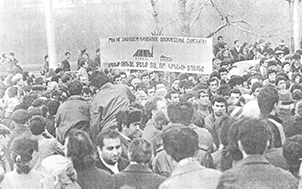
THE SUMGAIT MASSACRES: FEBRUARY 1988
28.02.2022
The reopening of the Artsakh issue became one of the manifestations of Gorbachev’s policy of restructuring (перестройка) and publicity (гласность). A special session of the Nagorno-Karabakh Regional Council decided, on February 20, 1988, to request the withdrawal of the Nagorno-Karabakh Republic from the Azerbaijan SSR, and for its unification with Soviet Armenia. It also requested that the Supreme Soviets of Azerbaijani SSR and the Armenian SSR mediate before the Supreme Soviet of the USSR for a positive solution of the issue.
In response to the just legal decision of the Armenians of Artsakh to exercise their right to self-determination, massacres and mass deportations of the Armenian population began in the Armenian-populated regions of Azerbaijan in February 1988. The first victim of Azerbaijan's policy of forcibly suppressing the free will of the people of Artsakh became the city of Sumgait’s Armenian population. It was there that, on February 27-29, the Armenian population of the city was annihilated exclusively for being Armenian. This was despite the city being considered a symbol of internationalism.
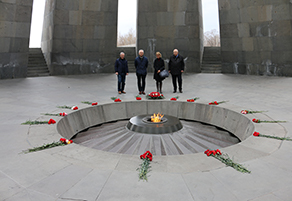
Country Manager of the World Bank for Armenia Carolin Geginat visited the Armenian Genocide Memorial
26.02.2022
Country Manager of the World Bank for Armenia Carolin Geginat visited the Armenian Genocide Memorial, on February 26.
AGMI Director Harutyun Marutyan welcomed the guests and told the history of the creation of the Memorial.
Ms. Geginat and the guests put flowers at the Eternal Flame and honored the memory of the innocent martyrs with a minute’s silence.
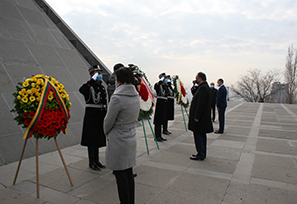
Chief Commissioner of the Police Department of the Ministry of Internal Affairs of the Republic of Lithuania Renatas Požėla visits the Armenian Genocide Memorial
23.02.2022
The delegation led by the Chief Commissioner of the Police Department of the Ministry of Internal Affairs of the Republic of Lithuania Renatas Požėla, who arrived in Armenia on a working visit, visited the Armenian Genocide Memorial on February 23 accompanied by the RA Police Chief Vahe Ghazaryan and Ambassador Extraordinary and Plenipotentiary of the Republic of Lithuania to Armenia Inga Stanite-Tolochkiene.
AGMI Director Harutyun Marutyan welcomed the guests and told them the history of the creation of the Memorial. He also related the story of the 3 khachkars placed in Tsitsernakaberd Park dedicated to the memory of the Armenians who perished during the ethnic cleansing of the Armenian population within Azerbaijan at the end of the last century.
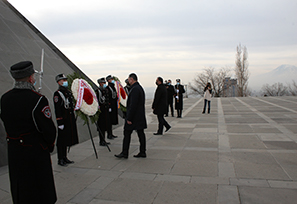
Georgian Interior Minister Vakhtang Gomelauri visited the Armenian Genocide Memorial
03.02.2022
The delegation led by the Minister of Internal Affairs of Georgia Vakhtang Gomelauri, who arrived in Armenia on a working visit, visited the Armenian Genocide Memorial on February 3, accompanied by the Head of Police of the Republic of Armenia Vahe Ghazaryan.
The guests were welcomed by the director of the Armenian Genocide Museum-Institute Dr. Harutyun Marutyan who presented to the guests the history of the memorial.
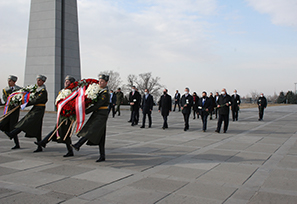
Austrian Federal Minister for European and Foreign Affairs Alexander Schalenberg visits Armenian Genocide Memorial
02.02.2022
The delegation led by the Minister of European and Foreign Affairs of the Republic of Austria Alexander Schalenberg, who arrived in Armenia on a working visit, visited the Armenian Genocide Memorial on February 2 accompanied by the Minister of Foreign Affairs of the Republic of Armenia Ararat Mirzoyan.
The guests were welcomed by the director of the Armenian Genocide Museum-Institute Harutyun Marutyan who presented the history of the memorial.
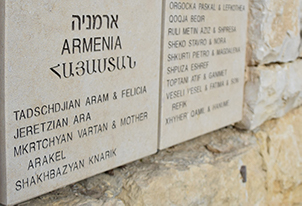
Righteous Armenians of the Holocaust
01.02.2022
The stories of the genocides are full of tragedies and atrocities. Hundreds of thousands of people were involved in the murder process, becoming mass murderers.
However, at the same time, unparalleled examples of compassion and heroism are encountered, when certain individuals, risking their lives, saved their comrades, friends and even strangers who were targeted by the genocide.
Yad Vashem, the World Holocaust Remembrance Centre in Jerusalem commemorates the names of about 20,000 people who saved others. This is not a large number, considering that the number of people in the regions subject to the Holocaust reached several hundred million.
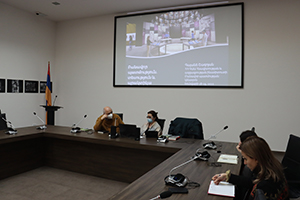
A SERIES OF LECTURES ON ORAL HISTORY
29.01.2022
Dr. Gayane Shagoyan, a leading researcher of the Institute of Archaeology and Ethnography, National Academy of Sciences of the Republic of Armenia, gave three thematic lectures at the Armenian Genocide Museum-Institute’s conference hall on the 18th, 19th and 22nd of January.
The topic of the lectures was oral history and its methodology. Their titles were:
. Theory and practice of oral history,
. Oral history in the museum,
. Questions and answers: ethnic and legal aspects.
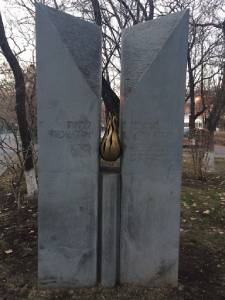
Holocaust Remembrance Week at the Armenian Genocide Museum Institute
26.01.2022
Holocaust Remembrance Week to be marked at the Armenian Genocide Museum Institute on January 27 - February 2, 2022:
27.01, 14:00 - Visit to the Holocaust Memorial.
29.01- 29.01 – Public lecture of Tali Nates, Director of the Johannesburg Holocaust & Genocide Center: "A Second-Generation Journey: From Schindler’s List to the Creation of the Johannesburg Holocaust & Genocide Centre" at AGMI Conference Hall, at 11:00.
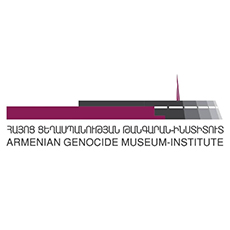
20.01.2022
Dear visitor,
According to the decree No. 02-N, dated January 7 by the Ministry of Health of RA, from January 22, upon entering the Armenian Genocide Museum-Institute you will be asked to provide
- a PCR test certificate with a negative result which was obtained not more than 72 hours before; or
- a reference from ARMED system, confirming the negative result of rapid antigen detection test for COVID-19 pre-qualified by the World Health Organization, not older than 24 hours; or
- a vaccination certificate via mobile application or present the printed version of the certificate exported from the application with a QR code.
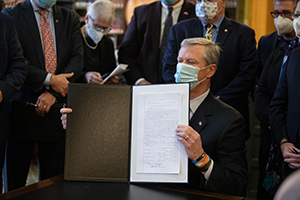
Teaching the history of the Armenian Genocide has become mandatory in another US state
14.01.2022
Teaching about genocide will be mandatory in middle and high schools in the state of Massachusetts in the United States of America. On February 2, 2021 a group of lawmakers submitted bill No. 692 to the Massachusetts Senate and the House of Representatives for approval on teaching about genocide which was signed by the governor on December 2, 2021, thus gaining legal force. It will be implemented in the new academic year, from July 1, 2022.
The bill is the result of 12 years of consistent work. It was drawn up by Senator Michael Rodrigues, who initially included only the history of the Jewish genocide in the draft. However, seeing the American public ignorance of the crimes committed against humanity during World War I and II, the bill was expanded to include other genocides of the 20th century. The law intends (a) To achieve and promote the teaching of human rights issues in all districts, with particular attention to the study of the inhumanity of genocide, including but not limited to the Holocaust, the Armenian Genocide, the Famine-Genocide in Ukraine known as Holodomor, the Pontian Greek Genocide, the forcible transport of Africans to the Americas in the slave trade in the seventeenth through nineteenth centuries, the violence committed against indigenous people in the Americas, and more recent atrocities in Bosnia, Cambodia, Rwanda, and Sudan.
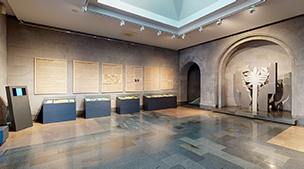
Another temporary exhibition on a virtual platform
A virtual tour of one of the exhibitions in the Armenian Genocide Museum
13.01.2022
The Armenian Genocide Museum-Institute Foundation, continuing to cooperate with the “On Point” organization, presents another temporary exhibition on its online platform, titled Tracing Armenian Claims: Ownership Certificates Relating to Individual and Community-Owned Armenian Assets. By visiting the AGMI website, it is possible to make a virtual tour of one of the exhibition halls in the Armenian Genocide Museum and thus see exclusive exhibits online, comprising about two dozen original Ottoman manuscripts and ownership documents, which are being displayed for the first time. Moreover, it is possible not just to see, but also to enlarge each image, read their main texts and explanations and to examine the exhibits themselves.
The above-mentioned exhibition will be open in the museum until April 23, 2022 and will be permanently available in the virtual version.
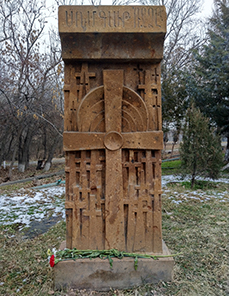
The khachkar on Tsitsernakaberd height dedicated to the memory of the victims of the Sumgait crime has been repaired
11.01.2022
The khachkar in the Tsitsernakaberd memorial garden dedicated to the memory of the victims of the Sumgait crime was restored in October last year. It had been erected there on April 24, 1988, watched by large numbers of people and emphasizing that the Sumgait tragedy is the continuation of the Armenian Genocide.
The ethnic cleansing and mass deportation of the Armenian population of Sumgait in Soviet Azerbaijan by the Azerbaijani authorities, from February 27 to 29, 1988, was aimed at preventing the further spread of the Artsakh movement and to threaten the Armenians with future bloody actions. The number of victims of the Sumgait massacre is still unknown. According to the official data from the USSR Prosecutor's Office, the number of people killed is 26 but, according to unofficial data, is several hundred.
The massacres organised at the highest state level in Sumgait on February 27-29 have not yet received an adequate political and legal assessment.
Dear visitor,
The Armenian Genocide Museum-Institute will be closed from December 31 till January 3, 2022.
Sincerely,
The Armenian Genocide Museum-Institute Foundation
| 




